#Artist: 空瓶
Explore tagged Tumblr posts
Text
【ROSE & Stardust & Qing Su】 迫不及待 【Cover】
Original Song : S,H,E
Vocalists : ROSE、星尘、青溯
Tuning:肺肺
Mixing:Chasel懿辰
Illustration:空瓶
PV:辻延soul
midi:某只泽
Planning : 李随歌
#五维介质#MEDIUM5#Quadimension#星尘#Stardust#星尘2024诞生日#星尘Infinity#Stardust Infinity#Rose synthv#qing su synthv#Artist: 肺肺#Artist: Chasel懿辰#Artist: 空瓶#Artist: 辻延soul#Artist: 某只泽#Artist: 李随歌#Artist: 婉霞#Music#Cover#Bilibili
4 notes
·
View notes
Text
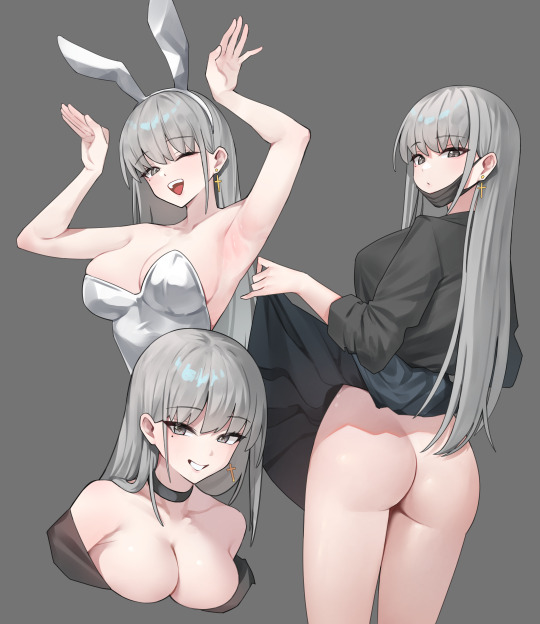
🤍ひかり🤍 by 空き瓶 [Twitter/X] ※Illustration shared with permission from the artist. If you like this artwork please support the artist by visiting the source.
648 notes
·
View notes
Text
Happy Gushiwensday Shabbes! Tonight we have two weeks' worth of poem for you, the hefty "Changping Arrowhead Song" of Li He!
The artist's brush paints the Redwater sands in ash and powdered bone while the murky old blood in the soil seeds copper flowers. The gleaming gold white-feathered shafts are long eaten away by the rain and my search finds only broken wolf's teeth still standing upright in the ground. I search the field so long my horse is exhausted; I must ride the other east from the relay station, over rocky fields, to the old wall drowned under wormwood. The wind is ceaseless, the sun's warmth brief, and the stars are dull. Black flags of wet cloud hang in the air and render day night. Souls on one side, spirits on the other, wailing from mouths of wasted flesh--- I promise them an offering of fermented milk and roast mutton when I'm done. For now I search: a wild goose writhing with worms, blighted reeds and bamboo shoots. The wind rises to see off its visitor and my little fire gutters in fear. An ocean overflows my eyes. I search, and find a snapped-off arrowhead. The fractured point is crazed with red, that once cut clean through flesh. A child comes riding south along the old east wall of the city telling me to change my gold for a bamboo shaft.
Plenty of notes and original text under the cut.
长平箭头歌
漆灰骨末丹水沙,凄凄古血生铜花。 白翎金竿雨中尽,直余三脊残狼牙。 我寻平原乘两马,驿东石田蒿坞下。 风长日短星萧萧,黑旗云湿悬空夜。 左魂右魄啼肌瘦,酪瓶倒尽将羊炙。 虫栖雁病芦笋红,回风送客吹阴火。 访古丸澜收断镞,折锋赤璺曾刲肉。 南陌东城马上儿,劝我将金换簝竹。
This one was kind of a lot! As with a lot of Li He's work I prioritized atmosphere, and taking a little longer to finish it let me also do some stuff with nonliteral translations + consonance and mouthfeel. I also did some maybe slightly awkward stuff to ensure that I could get the word "search" in every pair of stanzas to kind of underline that the poet is here aaaaall day long. Here are my notes.
The artist's brush --- this first line has a LOT of words that suggest paint or pigment! 漆 paint 灰 ash or lime 末 powder 丹 cinnabar and 沙 powder again (sand in this case). To me it suggested mixing pigments on a palette, except the pigments are poison ash and bone dust.
Redwater --- it's just called the Cinnabar River (in Shanxi), but I thought "Redwater sands" sounded very nice.
broken wolf's teeth --- Li He goes into more detail about why they're like wolf's teeth; they're serrated! The literal line is a fairly dry description of arrowhead morphology.
drowned under wormwood --- it doesn't say "drowned under" it just says there's wormwood/mugwort growing there, but its habit seems drownsome and I'm goth.
and render day night --- arguably it just says "in the night air" but when I thought about it it didn't make a ton of sense that he would be looking for relics on the battlefield at night so I decided it's a very overcast day.
Souls... spirits --- 魂 is an immortal soul and 魄 is a mortal soul. I'm not an expert on the distinction but it sounds pretty gnarly on the ghost plane around here.
I promise them an offering --- it's not outright stated but heavily implied that this is a food offering for the emaciated dead who haven't received offerings in centuries because their bodies weren't recovered by family.
my little fire gutters in fear --- I'm not super sure about this one. It literally says 吹阴火 blow yin fire, and I don't know how to interpret "yin" here. Laurence had yin fire as "ghost fire" which is cool. I'm playing more in the space of yin as darkness or diminishing, but not in a way that's, like, grammatical.
An ocean overflows my eyes --- 丸澜 is a fun idiom for crying, consisting of 丸 round things [tears] and 澜 swelling water.
crazed with red --- this one puzzles me. We think it's more likely the arrowheads are bronze (maybe the 'copper flowers' mentioned above), not steel, so they wouldn't be rusting, and the red is 璺 cracks, not just dried blood. Maybe blood that has the appearance of cracks? I chose a somewhat nonliteral word for this reason.
change my gold --- otherwise known as "buying." I think the reason he didn't just say "buy" was probably metrical, but I feel like the exchange is kind of striking and wanted to draw attention to it; it has something to say about tourism, the commodification of emotion. It's a pretty striking end for this poem wherein the poet has spent hours listlessly haunting the battlefield with the rest of the ghosts, weeping, and now a kid is trying to sell him souvenirs.
bamboo shaft --- there's some debate about the identity of the souvenirs: are they arrowshafts, or are they offering plates for temple sacrifices of meat? I chose to go with arrowshafts because it feels more... kitschy and pointless.
14 notes
·
View notes
Text






<Hemingway’s Fly Bottle (*1)/Another Heart (*2)>
7/21/2024 (The 125th Anniversary of Hemingway’s Birth)
by Masahide Kobayashi 6.6 (φ) × 35.5 (H.) cm 364 g Mixed Media
Slightly Iridescent Clear Bottle with Octagonal Lower Half and Round Upper Half (Glass)
Folded/Woven-blade Silver-grass-hopper (Plant Fiber)
Pine Stick (Plant Fiber)
Chocolate-colored Thong (Leather)
(*1) [https://www.mutualart.com/Artwork/Flies-in-a-Bottle/1A3B028FC320BED32F4E681CC2D0615F]
(*2) [https://reslater.blogspot.com/2011/07/big-two-hearted-river.html]
<ヘミングウェイのフライ・ボトル (*1)/もう一つの心臓 (*2)>
7/21/2024 (ヘミングウェイ生誕125周年記念日)
小林正秀 作 6.6 (φ) × 35.5 (H.) cm 364 g 混合材
下半分が八角面取りされ、上半分が丸い、僅かに銀化した透明瓶 (ガラス)
バッタの形に折った/編んだススキの “折り葉”/草編み玩具 (*3) (植物繊維)
松の木の小枝 (植物繊維)
チョコレート色の紐 (革)
(*1) この言葉は、デヴィッド・ハモンズの (何本かある “ボトル・アート” の中の) 少なくとも6本は数えられる “フライ・ボトル” の連作の一つ、<ボトルの中のフライ (瓶の中の蝿)>の題名に負っている ([https://www.mutualart.com/Artwork/Flies-in-a-Bottle/1A3B028FC320BED32F4E681CC2D0615F])。

この連作では、透明な瓶の内側に接着剤で貼り付けたジッパーの引手を、止まった「蝿=“fly”」に見立てているわけだが、“fly” は「ズボンのボタンやジッパーを隠す覆い布」の意味もあって、恐らくこの縁語か��、この見立てが思い付かれたのではないだろうか。
この作品のボトルは連作中唯一「ペット=“PET”」だが、上述の「6本」の中には拙作同様ガラスのボトルもあり––––

([https://newyorkarttours.com/blog/art,artist,contemporary,critic,exhibition,gallery,newyork,photography,sculpture,tour,visualart/bottles/]-右から四本目のワインの瓶)––––また、上述「6本」の内の残る4本は、ガラスはガラスだが、「ボトル (細首/細口瓶)」ではなくて「ジャー (“jar”=広口瓶)」である

([https://www.mutualart.com/Artwork/Fly-Jar/624F86C99BE1B1E9]/

[https://www.mutualart.com/Artwork/Fly-Jar/01A3D05CA4FFA6D7]/

[https://lesoeuvres.pinaultcollection.com/en/artwork/one-stone-head]-1994/

[https://greg.org/archive/2024/03/02/shoo-fly-shoo.html]-1994-蝿が黒人で瓶がニューヨーク市ハーレムの「ゲットー (“ghetto”)」を表しているとのことだが、今は瓶がガザで蝿はパレスチナの子どもたちに見えてならない)。
拙作の「フライ (“fly”)」 は、蝿ではなくて「���りの擬似餌=ルアー (“lure”) の一種である毛鉤 (“fly”)」––––飛ぶ (“fly”) 虫であるバッタ (「飛蝗」) の形に折った (折り紙ならぬ) “折り葉”/バッタの形に編んだ「草編み玩具」(*3) ––––である。
(*2) この言葉は、ヘミングウェイの最初の本格的な短編集である《我らの時代に = In Our Time》(1925 刊) に収められた〈大きな、二つの心臓のある川 = Big Two-Hearted River〉(1924-5 執筆) の題名に負っている。
この小説の第二部に、革紐で首から下げたバッタを入れたガラス瓶––––拙作の題名で言えば “フライ・ボトル”/原文では “グラスホッパー・ボトル” ––––が胸にぶつかって揺れたとあり、そこから、この瓶を、胸中の心臓の近くで揺れる胸外の “もう一つの/(二つある内の) 二つ目の心臓” に喩えた。
「かれは空の瓶を手にすると…草地に行った。……餌にするバッタを捕まえたかった。おあつらえむきのバッタが一杯…草の…根もとにいた。……中ぐらいのサイズの茶色いバッタを五〇匹くらい瓶に入れ…/…栓がわりに松の枝を押し込んだ。それで、バッタたちが逃げ出せないくらい瓶の口はふさがったし、通気にも問題なかった。/////// かれは…バッタの入った瓶の口を革紐で片結びにして、首から下げて、流れの方へと降り…た。…/… バッタの入った瓶が胸にぶつかり揺れた」––––アーネスト・ヘミングウェイ著, ニック・ライアンズ編, 倉本護訳『ヘミングウェイ釣り文学傑作集』木本書店, 2003, pp.46-8。
“he took an empty bottle and went…to the meadow. …Nick wanted to catch grasshoppers for bait…. He found plenty of good grasshoppers…at the base of the grass…. ……Nick put about fifty of the medium browns into the bottle. …/……Nick put in a pine stick as a cork. It plugged the mouth of the bottle…, so the hoppers could not get out and left plenty of air passage. /////// He started down to the stream, …the bottle of grasshoppers hung from his neck by a thong tied in half hitches around the neck of the bottle. …/…The grasshopper bottle swung against his chest.” –––– “Hemingway on Fishing” : Ernest Hemingway; edited by Nick Lyons, Lyons Press, 2000 ([https://www.amazon.com/Hemingway-Fishing-Ernest/dp/1585741442/ref=sr_1_1?crid=3ILB53P3QFMOI&dib=eyJ2IjoiMSJ9.JjbqJHremWZ5h_HnJQ9i8Q.bYOfxz8ItEOecHZymhUdroQz23LL5duJsEuP2ywH-Bw&dib_tag=se&keywords=hemingway+on+fishing%2C+lyons+press&qid=1718868802&s=books&sprefix=hemingway+on+fishing%2C+lyons+press%2Cstripbooks-intl-ship%2C251&sr=1-1]), pp.13~6.
この本の写真頁 (上掲ハードカヴァー版原書には有るがスクリブナーズ社刊のペーパーバック版には無い) の7枚目に––––「1916年頃、釣行でのE・ヘミングウェイ。『大きな、二つの心臓のある川』で描かれるバッタを詰めた瓶を首にかけている」(“EH on a fishing trip, c. 1916. Note the grasshopper-holding bottle around his neck that would find its way into ‘Big Two-Hearted River.’”) ––––とのキャプションが付された写真が収録されている。

つまり彼がまだ高校卒業前の––––(卒業を目前に兵役志願するも左眼弱視で叶わず、代わりに) 1918年の春、赤十字野戦病院���送車の運転手に志願して北イタリア戦線に配属され、2週間後には19歳の誕生日を迎えるという7月8日の深夜にヴェネツィアの30キロ北東を流れるピアーヴェ川西岸のフォッサルタ・ディ・ピアーヴェで (一説によるとイタリア兵にチョコレートを配っていた時に) オーストリア軍の迫撃砲弾と機銃掃射を浴びて重傷を負う前の––––この写真は、上で引用はしなかった瓶以外の装備……竿や手網や、肩から吊るして膝下まで長く垂らした (釣った魚を水中で生かしておく生簀としての) 布袋や、(これは中が見えないので作中の記述に従っての推測だが)「ランチや毛鉤入れ帳でふくれ上がっ…た」「シャツの胸ポケット」(同上 p.48) 等……も含めて、作中の描写にそっくりである。
この小説は、(3ヶ月の入院と10数回にわたる237個の砲弾破片・銃弾摘出手術を経て帰国後の) 1919年9月に、昔のように友人らと釣りに出掛けた体験を基に、(しかし作中では彼らを消して主人公のニック唯一人が) 大自然との遣り取りを通して、戦場だった “彼の川” での心身の傷を、平和な “此の川” で癒し回復して行く過程を表した作品だが、このバッタ=“grasshopper” は––––彼自身も含めた––––戦火に追われ傷つけられる犠牲の草の根の民=“grassroots” を表しているように思う。
例えば第三短編集収録の〈人こそ知らね = A Way You’ll Never Be〉(1932執筆, ‘33刊) の中でも––––「この軍服を着た…数万の兵隊が、バッタ (ローカスト) の大群の如くやって來るよ」(谷口陸男訳, 三笠書房版全集1, 1955, p.156, 但し (ローカスト) は元文では行間に振られたルビである:“you will see…millions wearing this uniform swarming like locusts”-[https://gutenberg.ca/ebooks/hemingwaye-winnertakenothing/hemingwaye-winnertakenothing-00-h.html#story06awayyoullneverbe]-par.100)––––という風に、(確かに揃いの軍服を着て揃いの行動をする軍団を、「相変異」を起こし「群生相」となって飛来襲撃するバッタの群団になぞらえるのは極く常識的で常套的な連想とは言え) 徴集された民衆兵がバッタになぞらえられ、また “此の川” の岸で瓶に入れられたバッタも元は「草の…根もとにいた」(“They were at the base of the grass”) のであり、更には、小説の第一部で主人公は (戦火の換言に他ならぬ) 火事で焼き尽くされた町シーニー (Seney) を通り過ぎて行くわけだが、そこで見たバッタは––––「どれも煤けて黒い色をしていた。……焼け野原で暮らしているのでみな黒く変色してしまったのだ…。火災は一年前だった…が、バッタは今もみな黒く変色している…。いつまでこんなふうに変色したままの姿なのだろう、とかれは思った。…/『さあ、行くんだ、…どこかへ飛んでゆけ』/ かれはバッタを空中に投げ上げ、道の向こう…へと飛んでゆくのを眺めた」(同 p.36)––––のである。
この末尾は犠牲からの治癒と回復への希望・願望だが、バッタの犠牲面に絞ってここで更に付言すると––––これは拙作の瓶の銀化とも結果的に照応してくるのだが––––この黒いバッタの「ほこりをかぶった背中や頭…は虹色だった」(同上, “it was … iridescent where the back and head were dusty”-ibid.)––––という。そしてこの虹色=“iridescence” は、実は、上で触れた第三短編集収録の別の短編〈死体の自然誌 = A natural History of the Dead〉(1929-21執筆, ‘32+’33刊) の中の、兵士の死体を自然誌的に描写した箇所にも出てくるのである。––––「暑いところに…放って置かれると肉はコールタールに似てくる。特に損傷した箇所には、タールの表面に見られるような虹色の光彩が現れる」(“If left long … in the heat the flesh comes to resemble coal-tar, especially where it has been broken or torn, and it has quite a visible tarlike iridescence”-[https://gutenberg.ca/ebooks/hemingwaye-winnertakenothing/hemingwaye-winnertakenothing-00-h.html#story11anaturalhistoryofthedead]-par.8-l.4)。……つまりこのバッタたちは “生きている死体 (the living dead)” なのである。
そして終いには、この「道の向こう」の……第二部の瑞々しい緑の渓谷に生きる健康なバッタたちもまた、瓶の中に囚われた後は生きたまま魚の餌として犠牲になる運命にあるわけで、その心臓は––––一寸のバッタにも五分の心臓がある––––主人公の胸の前で同じ鼓動を打つ同じ犠牲の草の根の民であることを証しているのである。……この瓶は、彼のもう一つの––––川ならば湧き/噴き出る水源としての––––心臓に他ならない。
周知のようにシーニーの町の側を流れる川は、実際はたったの3文字から成る単純な1音節名詞1語のフォックス川=Fox River なのだが、彼はそれを、その遥か北東に在る––––3文字+7文字の2語3音節から成る長く複雑な形容の––––川の名と取り替えている (これに Big も加えた形容全体の構造/型式は……あの倭建命の「{倭は国の眞秀ろば} 畳なづく青垣 山籠れる 倭 {し麗し}」にも似た……第三短編集収録の〈清潔な、明るい光の差し込むところ = Clean, Well-Lighted Place〉という題名と同じである)。

(via [https://reslater.blogspot.com/2011/07/big-two-hearted-river.html])
この “grasshopper” への “grassroots” の仮託は、旧約の『イザヤ書』(Is. 40–22~24) の昔から––––「主は地球のはるか上に座して、地に住む者をいなごのように見られ……また、…無きものとせられ、…むなしくされる。彼らは…植えられ、…まかれ、…地に根をおろしたとき、神がその上を吹かれると…枯れて、わらのように…風にまき去られる」(日本聖書協会『旧約聖書』1955年改訳 p.998) ––––と有るように、極めて馴染み深いもので、例えば現代の絵画でも––––Web 上では今はこの<赤バッタ、青バッタ>しか画像が見出せない

([https://www.nihonbijyutukai.com/anpan/archives/archives57])––––長谷川匠のバッタ連作が思い出される (「なお,伝統的に日本では,聖書…や欧米の文学書など…,飛蝗…を〈イナゴ〉と訳してきたが,これは〈バッタ〉と訳すべきものである」-[コトバンク-バッタ-改訂新版 世界大百科事典]=[https://kotobank.jp/word/バッタ-115128#goog_rewarded]-山崎柄根執筆部分より)。
この、聖書からの引用という繋がりで––––否、この短編集が刊行された百年前と今が何一つ変わらぬ戦火/戦禍の拡大/継起の時代だからという繋がりで––––最後に一言付け加えるが、この短編集の題名《我らの時代に》は……ヘミングウェイの作品 (と、併記するのは気が引けるが拙作) の題名が多くそうであるように……ある出典からの引用で、それは、英国国教会 (“Church of England”) の『祈祷書』(“The Book of Common Prayer”) の「晩祷」(“The Order for Daily Evening Prayer”) の中の––––「おゝ主よ、我らの時代に平和を与えたまえ」(“Give peace in our time, O Lord”-[http://justus.anglican.org/resources/bcp/1928/BCP1928.pdf]-p.31-l.9)––––だという。
(日本聖公会の1895年版『祈祷書』-[https://dl.ndl.go.jp/pid/824979/1/1] では、この言葉は「晩祷」ばかりでなく「早祷」にもあって、どちらも會師の先唱 :「主よ。我らの生涯泰平をあたへ給へ」で、また、これに対する會衆からの応/答唱は「地のはてまで戦争をやめしめ給へ」([ibid.-1/34],[ibid.-1/45]) であり、戦後の1959年版では、司式者先唱 :「主よ、この世を安らかに治めたまえ」と、会衆応/答唱 :「地のはてまで戦いをやめしめたまえ」である-p.73, p.84)。
……いずれにせよ、この、記されず/発せられず/海面下に沈んで隠された氷山の言葉を––––それをヘミングウェイの非情と反語がどう捉えていたかは別にして––––私たちは私たちの「我らの時代に」、今一度新た��/改めて思い発 (おこ) す必要があるのではないだろうか。
(*3) 新崎宏『手遊び 草編み玩具 第1巻』琉球新報社, 2011, pp.62~3 (沖縄型)/ 65~7 (普及型)/ 69~74 (中国型)。
[https://www.youtube.com/watch?v=mxb3Z399GNM]。
[https://www.youtube.com/watch?v=I_opJ2xl_Fk]。
追記
1989年の3月13日から4月8日にかけてパリの【Galerie 1900 ▾ 2000】で開催されたジョゼフ・コーネル展のカタログ–––– Edouard Jaguer, “Joseph Cornell”, ©1989 The Joseph and Robert Cornell Memorial Foundation [https://nostos.jp/archives/363284] ––––には、 いずれも1933年頃の作とされるコーネルの4本の “ボトル・アート” ––––色々な物品が中に入れられた沢山の小瓶を一つの箱に収めた広義の “ボックス・アート” とは異なる “一本瓶もの” の作品––––の写真図版5枚が収載されている。
その内<無題 (中国の瓶)>(p.20) と<無題 (月の瓶)>(p.21) の2枚=2作品はカラーで、


3枚の白黒は、<無題>と、<無題 (バッタの瓶)>の全図 (p.22) とその部分拡大図 (p.11) である。



<…中国の瓶…>に入れられた活版印刷本の頁らしき巻かれた紙の右端一行は、漢字に [平仮名のルビ] を振った漢字+平仮名交りの日本語の文章で––––「食物 [しょくもつ] を與 [あた] へて汝 [なんぢ] ‥ 今 [いま] より我子 [わがこ] ‥ 做 [な] れよと云 [い] は」––––と読め、従ってこれは、<…日本の瓶…>と改めた方が良いのではなかろうか。
それはともかくとして、コーネルにも<…バッタの瓶…>が有ったということだが、このバッタは、(解説も無く拡大図でも判別し難いのだが) ひょっとすると腹の下にゴムの吸盤が付いていて、何かに押し付けて初めのうちは平らに伏せて耐えているが、そのうちに吸盤の効力が失われて針金の脚のバネの反発力で突然跳び/跳ね上がるブリキの玩具の「跳ねバッタ」––––(例えば[https://www.ebay.com.au/itm/181510296673] 、[https://www.jataff.or.jp/konchu/obj/obj30.htm] 、[https://www.amazon.co.jp/ノーブランド品-q1145510112-ブリキのおもちゃグラスホッパー雑貨ブリキ玩具品駄菓子屋懐かしコレクション絶版品バッタレトロ品珍品/dp/B0D9WKKWX4] のような) ––––かもしれない (但し写真を見る限りでは吸盤は……初めからなのか、後で取れたのか、は兎も角として……付いていない)。
なお、1980年のニュー・ヨークMoMa でのジョゼフ・コーネル展の図録 ([https://nostos.jp/archives/49182]) には、反対側から異なる角度で撮られたと思われる内容物品の配置が違うこの瓶の白黒写真図版 (Pl. 12)

が掲載されている。
(10/14/2024)
2 notes
·
View notes
Text
TEDにて
ファビアン・エーフナー: とても色彩が鮮やかなアート・サイエンス
(詳しくご覧になりたい場合は上記リンクからどうぞ)
スイス人のアーティスト兼写真家のファビアン・エーフナーは、日常の科学からキラリと光るアートを生み出すことを試みています。
魅力的な講演で、音波と戯れる顔料の様子を捉えた写真など、最近撮影したサイケデリック(とても色彩が鮮やか)な写真を紹介します。
リアルタイムなデモでは、磁性液体と絵の具を混ぜたり、ウィスキーに点火したときに起こる現象にご期待ください。
磁性流体とは、とても変わった動きをします。真っ黒の液体で油のような流動性を持っていて金属の微粒子が含まれるため磁石に反応します。この液体を磁場に置くことで外観が変わります。
また、暗室で再現したスローモーション映像でご覧ください。ガラス瓶の中で炎は上から下へ移動しアルコールが混ざった空気を燃やして行きます。
ですから、先ほどご覧いただいた写真は、容器の中を移動する炎を瞬間的に捕らえたもので上下逆にしてあるので180度逆にしたものを想像してください。この写真はこんな風に撮影されました。
シャボン玉が弾ける。まさに、その瞬間を捕らえたこちらの写真。小さな油性ペンキの粒からなる銀河もあります。
特異な性質を持つ不思議な液体。遠心力が形作る絵の具などです。常に、アートと科学の融合につとめています。
そして、どう、やったら音の波を可視化できるか?こんなことを思いつきました。スピーカーを用意してその上に薄いプラスチックホイルをのせます。
その上に顔料をのせました。スピーカーの上にです。すると、スピーカーを通して音楽を再生することで振動で顔料が上下に動きます。高速で行われるので瞬く間の出来事です。
1秒あたり3千フレーム以上とらえるカメラを用意して、その様子を撮影しました。
ムーアの法則により、TFLOPS(テラフロップ)クラスにまで到達したCPUの処理速度の向上、ナノテクノロジーによる小型化・高性能化や、IT技術の発展やテラバイト規模の記憶容量の向上に関係しています。
ナノテクノロジーといわれるもので・・・
ナノテクノロジーは、物質をナノメートル (nm)の領域すなわち原子や分子のスケールで、自在にコントロールする技術のことである。
この技術によって、原子や分子の一個一個を単独でつまみ上げ、移動し、築き上げることも可能になっています。現在は、新素材やコンピューターのCPUの製造過程で現実に応用されています。
電子回路のトランジスタは、だいたい数十nm程度の大きさで、カーボンナノチューブなども同様です。物質を数ナノメートルの大きさにすると、量子効果と呼ばれる特殊な現象が発現する。
例えば、電子の閉じこめによるエネルギー準位の離散化があらわれる大きさや、トンネル効果など。量子力学を応用することでコントロールが可能になっています。
こういう新産業でイノベーションが起きるとゲーム理論でいうところのプラスサムになるから既存の産業との
戦争に発展しないため共存関係��構築できるメリットがあります。デフレスパイラルも予防できる?人間の限界を超えてることが前提だけど
しかし、独占禁止法を軽視してるわけではありませんので、既存産業の戦争を避けるため新産業だけの限定で限界を超えてください!
(個人的なアイデア)
One such rocket engine, about one hundred million yen units in a unit of several hundred million yen It is real to realize the product in the price range that can not reach the price range of hundreds of thousands of yen reaching ordinary people with technologies far beyond the limits of human beings It may be an innovation that will become a plus-sam of it.
こういうロケットエンジン、ジェット機くらいのひとつ数億円単位で手の届かない価格帯の商品を庶民に手の届く数十万円くらいの価格帯に人間の限界を遥かに超えるテクノロジーで実現することが本当のプラスサムになるイノベーションかもしれません。
In the low price area below this level, the danger of a negative spiral, which only causes deflationary streams and wages do not rise, may have emerged concretely around 2018 with the development of the Internet since Millennium.
これ以下の低価格領域はデフレストリームを引き起こすだけで賃金が上がらない負のスパイラルの危険性がミレニアム以降インターネットの発展とともに2018年あたりから具体的に出てきてるのかもしれない。
<おすすめサイト>
リフィク・アナドル:人工知能の時代におけるアート
エヴァン グラント:サイマティックスで音を可視化する!
ラメッシュ・ラスカー: 毎秒一兆枚の高速度カメラ
リチャード・ドーキンス:「奇妙な」ユニバースを語る!
エイブ・デイヴィス:物の隠れた性質を��き明かす新しい映像技術
マイケル・ルービンスタイン:見えない動きを見、聞こえない音を聞く。すごい? それとも気味が悪い?
<提供>
東京都北区神谷の高橋クリーニングプレゼント
独自サービス展開中!服の高橋クリーニング店は職人による手仕上げ。お手頃50ですよ。往復送料、曲Song購入可。詳細は、今すぐ電話。東京都内限定。北部、東部、渋谷区周囲。地元周辺区もOKです
東京都北区神谷高橋クリーニング店Facebook版
#ファビアン#エーフナー#CPU#GPU#アート#芸術#日常#リアル#タイム#化学#エヴァン#エヴァ#グラント#カオス#量子#デザイン#ラメッシュ#ラスカー#NHK#zero#ニュース#発見#discover#discovery
0 notes
Text
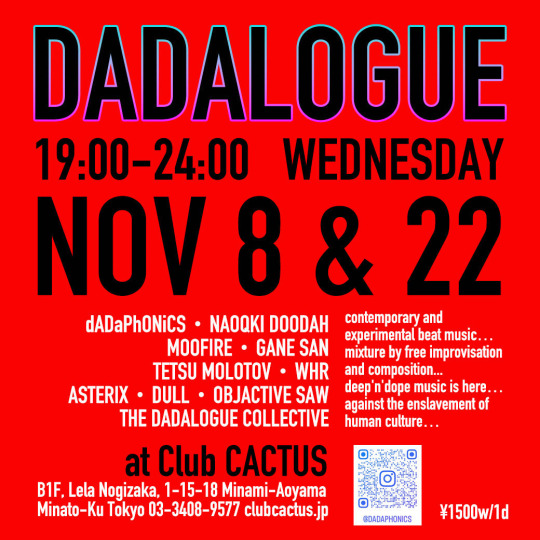
☆☆☆☆☆☆☆☆☆☆
'DADALOGUE'のfree style集団即興演奏(Dadalogue Collective)は、テーマやモチーフなど全く無い状態で、集ったアーティストが互いの音や空気感に反応しつつ出発、音が自然に融合しながら展開して行く、完全に自由な集団即興演奏ですが、今回より新たにリーダー(複数人有り)を立て、その人が発するトラックや楽器演奏に全員が反応して行くと一体どんな音楽が聴こえて来るか?!
そんな実験を行います。
従来の完全自由集団即興演奏も引き続き行います。
8日のリーダーは
"Tetsu Molotov"
- electronics, voice
"objective-Saw"
- electronics, poetry, rap, toasting, guitar, soprano recorder
の御二方!!
そして、ゲスト参加者も大歓迎です!
ただ、まるで競技か���道場破りか、はたまた、親の仇の戦の如くのEgo丸出しの方は誠に恐れ入りますが御遠慮願いますwww
あくまでも、融合-Unityで有り、決して、闘い-Fightingの場では有りません。
自身の音のみならず、他の全ての奏者の音も常に聴こえる音量を基本的に維持するのが唯一のルールの様な物です。
演奏の流れから全体が自然に轟音カオス状態になるのは有りかと思いますが、それはOKです。
これらを留意しながら進行して行くと非常に美しいサウンドが必ず生まれます。
いみじくもTetsu Molotov(火炎瓶テツ)氏が言った"未定調和"。。。
その音楽(サウンド)は、美味しい物でも呑みながらリラックスして、様々な不可思議な音の振動に身を任せて居ると、身体と脳が何だか普段のルーティンから遠く離れて帰って来て、仕舞いに凝りが解れます 😂
☆☆☆☆☆☆☆☆☆☆
'DADALOGUE's free style collective improvisation (Dadalogue Collective) has no theme or motif at all, and the gathered artists react to each other's sounds and atmosphere, and the sounds naturally fuse and develop. It's a completely free collective improvisational performance, but from this time onwards, we appoint a new leader (there may be more than one person), and what kind of music will we hear when everyone responds to the track and instrument performance played by that person? ? !
We will conduct such an experiment.
The traditional completely free collective improvisation will also continue.
The leaders of the 8th are
"Tetsu Molotov"
-electronics, voice
"objective-Saw"
- electronics, poetry, rap, toasting, guitar, soprano recorder
And guest participants are also very welcome!
However, we apologize for the inconvenience, but please refrain from showing off your ego as if it were a competition, breaking the dojo, or even fighting your parents' enemies.
After all, it is a fusion-Unity, and it is definitely not a place for fighting.
Basically, the only rule is to maintain the volume so that you can always hear not only your own sound, but also the sounds of all other players.
I think it's possible that the flow of the performance will naturally cause the whole thing to become chaotic, but that's OK.
If you keep these things in mind as you proceed, you will definitely produce a very beautiful sound.
This is exactly what Mr. Tetsu Molotov called "undefined harmony." . .
That music (sound) is something that when you relax while drinking and surrendering to the vibrations of various mysterious sounds, your body and brain somehow become far away from your usual routine and come back to you. Relieve your stiffness 😂
☆☆☆☆☆☆☆☆☆☆
'DADALOGUE'
on 19:00, Wednesday, November 8, 2023
at CACTUS
contemporary and experimental beat music… by free improvisations and compositions...
deep’n’dope music is here…
against the enslavement of human culture…
"dADaPhONiCS"
are
'Naoqki Doodah'
- drums, looptracks, percussions, glockenspiel, guitar, viola, clarinet, mellophone, bass recorder, charamela, etc.
and
'Moofire'
- electronics, percussions, megaphone, voice
"Gane San"
- contrabass
"Tetsu Molotov"
- electronics, voice
"objective-Saw"
- electronics, poetry, rap, toasting, guitar, soprano recorder
"The Dadalogue Collective"
- collective improvisations
by "Tetsu Molotov" and "objective-Saw" and all performers and guests
¥1,500 w/1d
Club CACTUS
BF1, Leela Nogizaka bldg.
Minami Aoyama 1-15-18, Minato-Ku, Tokyo.
www.clubcactus.jp
#dadalogue #clubcactus #dadaphonics #naoqkidoodah #moofire #ganesan #tetsumolotov #objectivesaw #dadaloguecollective #tackbomb #taxihifi #soundsystem #freemusic #freeimprov #freejazz #bebop #spiritualjazz #blues #rock #punk #reggae #funk #hiphop #electronica #tribal #noise #experimental #avantgarde #diy #antiwar
0 notes
Text

町田出身アーティストのみで作られたコンピレーションアルバムがリリースされました!
https://linkco.re/YZ9QcTyx
地元を代表するアルバムの中におれらも選ばれるってのはマジで光栄な事。
NORMANDIE GANG BANDは"成瀬台"って曲で収録されてます!For all my homies and family🫶🏻
ARTIST : V.A.
(SATO MARIO, SMOKIN' IN THE BOYS ROOM, MUD, KNGO feat.トシロ, F.F.B, NORMANDIE GANG BAND, ICE CANDY, Motonari)
TITLE : Rep MCD COMPILATION ALBUM vol.2
LABEL : KLOVAL RECORDS
PRICE : ¥2,500 (tax in)
FORMAT : CD, 配信
NO : KLOVAL-77,78
RELEASE :
CD 2023/08/??
配信 2023/08/??
町田のクラブやストリートショップで突如配布され話題となった前作、
”Rep MCD COMPILATION ALBUM”から約9年。
街と人は移り変わりながら、シーンは未だ成長を遂げている。
今作はその期間を物語る様に、今尚ステージに立ち続けるアーティスト達による作品である。
今作は全曲のBeatを担当したGothamが、
町田をRepresentするアーティストの熱量に感銘を受けた所から制作が始まる。
歴史あるこの街から外に出て活躍する者、大舞台を夢見て奮闘する者、共に共通しているのはこの街を愛し誇りに思っている事。
パーティーが始まれば終わる事を知らず、
空いた酒瓶の山を見ながら朝日を浴びる。
BeatがかかればRapする声が聴こえ、
切磋琢磨と言う摩擦の音が鳴る。
唯一無二の熱い場所がここにある。
町田のシーンとアーティストにRespectを込めた、
Gothamプロデュースによる渾身の8曲に呼応するように、
町田をホームに活躍するベテランから若手アーティストまでが参加。
TRACK LIST :
1. Portrait 2023. / SATO MARIO
2. 廻 / SMOKIN' IN THE BOYS ROOM
3. S.O.T.C / MUD
4. Still Callin' feat.トシロ/ KNGO
5. Drunk / F.F.B
6. 成瀬台/ NORMANDIE GANG BAND
7. Lv.20 / ICE CANDY
8. Leave No One Behind / Motonari
All Songs Produced by Gotham
All Songs Mixed by Yastarize
All Songs Mastered by Yastarize
Art Work by BORIS & yunkmr
A&R : satoru & SMOKIN' ACE
Booking : [email protected]
0 notes
Photo

ついにタロットカードを! (続くのかわかりませんのんびりやります) 最近一番きになるカードの 星を描きました。 。 天空の庭 星が瞬き 雲の山に 水瓶から川が生まれる というお話も同時に生まれました。 。 るったんが大事に抱えているのがシリウスです。 タロットの真ん中の星がシリウスなのは描いた後に知ったのですが シリウスというのは、るったんの生みの親のシリンという人(狼さんのこと)のイメージの星でもあるので、 あ、お話的にも合っている! と嬉しくなりました! 。 #art #artist #artwork #tayasuisketches #fingerdrowing #doodle #illustration #kawaii #cute #originalcharacter #luche #girl #女の子 #アート #アーティスト #イラスト #イラストレーション #るったん #ルシェ #オリジナルキャラクター #オリジナル #かわいい #指お絵描き #アプリ #タロット #星 #タロットカード https://www.instagram.com/p/B4TcD4NFurl/?igshid=1qf5k2qfpgkka
#art#artist#artwork#tayasuisketches#fingerdrowing#doodle#illustration#kawaii#cute#originalcharacter#luche#girl#女の子#アート#アーティスト#イラスト#イラストレーション#るったん#ルシェ#オリジナルキャラクター#オリジナル#かわいい#指お絵描き#アプリ#タロット#星#タロットカード
2 notes
·
View notes
Text

アスナ by 空き瓶 ※Illustration shared with permission from the artist. If you like this artwork please support the artist by visiting the source.
846 notes
·
View notes
Photo

老Yang教员组今天给大家分享一篇艺术史essay代写范文,主要内容是讲:参观旧金山亚洲艺术博物馆是神奇的,令人愉快的。博物馆是一座三层楼高的建筑,有40000平方英尺的展览空间。地址是拉金街200号。在亚洲艺术博物馆,有拉贾斯坦邦宫殿的微缩画、日本著名漫画家手冢的卡通画以及中国明代的青瓷花瓶等珍贵藏品。亚洲艺术博物馆可以带给我魔法的力量。在我看来,在数千年的历史中,我将能够在一个下午环游半个世界。
同时有需要essay润色查重、辅导代写、托福GRE考试保分、网课全方位包课的家人们可以联系老Yang微信(Wechat ID: ymf2531)进行咨询喔~
The visit to Asian Art Museum of San Francisco is magical and delightful. The museum is a three-story building with 40,000 square feet of exhibition space. The address is 200 Larkin St. In the Asian Art Museum, there are precious collections such as miniature from Rajasthan palace and cartoon carved by the famous Japanese cartoonist Osamu Tezuka's, as well as China's Ming Dynasty celadon vases. Asian Art Museum can bring me to the power of magic. It seems to me that I will be able to make a travel halfway around the world in one afternoon through thousands of years of history.
In addition to its excellent exhibits, the ticket is not very expensive as $ 12. Asian Art Museum of San Francisco is free to the public in the first Sunday of each month, so if people want free tickets, then they are proposed to go early. There is also an official website for it. Before I visit it, it is very convenient to look for information on the Website: www. Asian art. Org. On the website, I learn about that Asian Art Museum of San Francisco is a museum full of collection of Asian artifacts, and its main collection is Chinese cultural relics. Its opening hours are from 10:00 to 17:00 and closed on Mondays. In addition, the museum's collection is in the form of continuous display. It provides telephone 415-581-3500. And the traffic is very convenient and I can take the J, K, L, M, N, F line subway.
The museum was officially opened in 1966. It is actually a celebration of International Art Symposium. There are more than 250 scholars from around the world, collectors and art merchants to participate. Before 1959, the only collection is known as Chinese art, including ancient bronzes, porcelain, and jade carving. After 1959, it increased collections of Korea, Japan, India and Southeast Asian countries and also increased the Chinese painting and calligraphy. The visit of the museum starts from Southeast Asia Island, advancing a little bit to inland areas of Asia. One of the most exciting parts is the China Pavilion, such as Dragon block from Spring and Autumn Period, and the jade of the He family -- a priceless gem from Warring States Period. There are worship and daily jade since the Western Han dynasties and older bronze tripod Jazz. The numbers are so large and make me feel a little more dizzying.
Within Asian Art Museum of San Francisco, there are a very small number of exhibits that are not allowed to take pictures, and these exhibits are marked with a special mark. Exhibits which are not marked specially are all allowed to take pictures. In the museum, I found the interpretation is rather detailed and orderly. For example, there is a lot of wood works on exhibit of the modern Japanese artists Okura Jiro. His main works are wall hanging and vessels made by black walnut and camphor tree. On the top of this interpretation card, there are Chinese names and years of production of exhibits given that the main audience of Asian Art Museum of San Francisco may be visitors from the Asian countries. The interpretation in English is listed below it giving a little detailed information of the source of exhibits. In the case of MU, 1990, the interpretation shows that those exhibits are given as a gift by Okura Jiro and there is detailed description of the creating place, background and process of Okura Jiro.
There are four main pavilions: Chinese Pavilion, Korean Pavilion, Japanese Pavilion and Indian Pavilion. The exhibits of Japan Pavilion have significantly increased in the museum after the opening. Now there are about 1600 items. I visited bronze ware such as circular mirror and bronze mirror of 3th century and pottery, ceramics and porcelain of 11th to 20th century. However, I still felt that the pottery, ceramics and porcelain appeal most to me. Thus, I will mainly give an account of my visit of pottery, ceramics and porcelain exhibits.
Entering the Japan Pavilion, I can see a very elegant tea house named “ Muchu an” as Japanese tea ceremony is a natural pursuit of easy, simple, and elegant atmosphere. It is made mainly of bamboo, wood, plaster and paper. The design of tea room is under the influence of the Zen idea, which tried to create an atmosphere of stillness and insight in general. In the non-decorated tea room, there are two things allowed: simple flower arrangement and Zen tea ware hanging on the wall. I imagined that when I bend down, and I got into the tea room, I looked up at the empty space where I saw the flower, and a little sunshine, sprinkled petals next to a simple Chan Yu calligraphy. This is an excellent scene full of Zen. This is a need to explain the feelings of Zen. The tea houses are usually divided into two parts as inner and outer tea court. There is line between the inner and outer tea court. This line has been given a profound meaning; this is boundary for people from one world into another world. At the same time the door is also charged with the function in particular to cut off from secular world in an instant as the guests walked through these boundaries. It is to clean itself from worldly distractions brought, while purifying the soul. The so-called door is a kind of limit. It is with this limit that it will produce an impression from one world into another world. By passing through this door, it means entering another world. The Japanese tea room is built out of bamboo and wood. Japanese tea room is not big, but it's not cheap. The cost of a first-class tearoom requires even more than one ordinary residence. Materials and processes used in a tea room are extremely delicate; every detail has been carefully considered; each configuration is imaginative. Another thing I noticed about the tea room is that it is extremely small. In such a small tea room, the space is already less than the space and distance that humans can psychologically tolerate and feel comfortable. The hosts and guests can only deal each other with candor, and you can not hide. Because of this, everything must be dealt in proper and perfect manners. Thus, the design and building of tea room is not so much about tea, but about the self-cultivation.
During all those Japanese items, Japanese tea ceremony is one of the most excellent forms of Japanese arts. Japanese tea ceremony began in China but also have its unique feature, and it is a special form of culture. It is the Zen Nippon that later gave birth to a unique aesthetic value. Japanese tea ceremony is developed from everyday life based on the activities of daily living. It is a melting furnace of religion, philosophy, ethics and aesthetics and has become a comprehensive arts and cultural activities. It is not just material things, but also ceremony learning, which can edify, and cultivate people's aesthetic and moral values.
Speaking of the Japanese tea ceremony, what is inseparable from the tea ceremony is tea wares. The appliances as large as furnishings rack, stove, and as small as tea spoons, glasses can all be called tea wares, but tea wares often specifically refers to tea bowls, teapots, and tea spoon. Tea wares are both ornamental and useful appliances. Utensils can be divided into public, which could be used by all the people on the scene and special ones intended for individual use. According to another division, tea ware of Japanese tea ceremony is broadly divided into two categories: one is dedicated to strong tea; one is dedicated to green tea. Both can be divided into many shapes such as the square dsih with bird design and the tea leaf storage jar of Bizen ware. It is one of the most expressive carriers of the tea ceremony. It not only stresses the adaptability to the different season, but also the arrangement of teahouse to help create a harmonious atmosphere. The variety of types of tea is made of porcelain, stone, lacquer, iron, copper, pottery, wood, bamboo. For example, the large dish with plant design, also one of so-called E-shino ware and bizen ware are both exhibits made out of stone. It is originated from Japan Tengen years of four hundred years ago. Shino were asking potters to make tea ware, which producing Japan's first white pottery ── " E-shino ". In General view, Shino has the qualities of the jade stones, and it has concisely glaze, minimalist natural texture rough adobe reckless, and simple and unadorned iron painting style. The potters left behind their fingerprints, fire marks, wormholes on the E-shino ware. The aesthetic charm, and life experiences of potters, is also involved in Shino pottery.
What I liked most is the Bizen ware. Its feature is not glazed, and does not have color painting. It relies entirely on the flame and techniques to make porcelain, and each piece is different. The family of master porcelain from the 15th century began to make Bizen-fired porcelain, and passed it through several generations ever since. The producing place of Bizen is one of the six ancient kilns in Japan. It has more than a thousand years of history, and in six of the kiln, is also the oldest. Another main place of tea utensils producing place is Seto where bottle with incised decoration is produced, a ceramic industrial city central and southern Honshu. It belongs to Aichi regions. In English "China" is porcelain, and in Japanese as "Seto wares" refers to porcelain. Seto kiln is the first kiln of Japan's six major kilns, and is known as the birthplace of Japanese pottery. Sales of porcelain store were the Japanese called "Seto house." Seto kiln began to imitate Chinese Qing porcelain of Yue kiln. At that time a large number of Chinese Song dynasty celadon enter Japan, but Japan failed to meet the aristocratic luxury consumption of Chinese porcelain, while China's tea party, tea bucket spread eastward, and makes black glaze tea produced in China Fujian kilns favored by the Japanese upper class. This greatly promoted the development of ancient Seto pottery industry. "Seto ware" features very rich ceramic glaze color, and its representative varieties are “yellow Seto," "Shino" such as large dish with plant design, "Oribe" such as square dish with bird design and so on. Their manufacturing history is hundreds of years old. "Seto wares" owes a lot to high-quality local clay, and in addition, the potter's art is quite superb.
The highest value of all the tea in most varieties and the most elegant undoubtedly is tea cup. Usually it is ceramic bowl, but there are stone products. In a sense, the bowl can be regarded as synonymous with the entire class of tea. It is designed and produced during Warring States Period by Rikyu. The famous potter Chojiro’s production of Black raku square tea bowl, known as "Kaburo" and can be regarded at the time in Japan as top works of tea cup (Britannica.com, 2016). I also found the famous wabicha. The tea ceremony is developed by Zen master monks in the 14th century and then adopted by wealthy aristocrats. They have built elaborate tea room, and they use Chinese imports as luxury tea wares. However, in the 16th century, tea master Rikyu presents a new way of tea ceremony, so that it can be carried out in a small tea house, and the tea is made of local artisans. Rikyu tea ceremony has conquered the less well-off people and become famous tea ceremony.
In addition, I also discovered from the interpretation that most of the tea utensils on display are made in Mino regions. Mino area (now Gifu Prefecture) is rich in the tea utensils because they have a wealth of ceramic materials - clay, so since ancient times they began to produce porcelain. According to legend, in the 7th century, it had built a local ceramic kiln. Later, the local porcelain continues to grow and develop, and now it is a rare giant ceramic production in the world. Now Japanese Mino made ceramic tableware production accounts for over 60% of the national market.
In addition to the using of clay ware for tea ceremony, Japanese stoneware or ceramics and lacquer, especially of Jomon period is significant as direct evidence of the history. Japan's first pottery started in the Jomon period. They are believed to be oldest, dating as early as the 11th century BCE and are discovered by a large number and remain similar in a large area. This suggests stable economy and trade between each other.
The ceramics also showed the economic status and life of people, and trade of that time. For instance, food serving dish with plant and half wheel design is a food containers of usually simple food like miso produced in Mino region and is placed opposite the food containers during the Momoyama period. It is also decorated with plant-shaped burn. And the large bowl with millet and sparrow design, made in Karatsu, is also full of millet and sparrow decorations. It is necessary to talk in detail about Karatsu. It means the leading port to the Tang dynasty. As the name suggests in Japanese, it has seen since ancient times the trade business of China and North Korea in Hong Kong. This reminds me of the trade between China and Japan in ceramics again. In general,the earliest exhibits of tea wares and cuisine wares of 16th century to 17th century are most stoneware. With the time advancing, Japanese porcelain is gaining more and more popularity. Stoneware is the roughest pottery; ceramic is a little more clear, and porcelain is the finest. And according to the interpretation, porcelain is the symbol of purity compared to stoneware. The development of Japanese porcelain firstly owe to the desire for Chinese and Korean ceramics, trying to imitate them. And the Japanese strive to create Japanese ceramics rivalling with Chinese and Korean ceramics, which has become Japanese potters’ goal through generations. The development of Japanese porcelain is associated with a powerful figure Toyotomi Hideyoshi during the Momoyama when he invaded Korea. This history is called "Ceramic war." This unjust war between the Korean people and Japanese people has brought about disaster and failure. But when the Japanese army retreated, they kidnapped Korean potters to Japan, leading to the unprecedented development of ceramics of Japan. Coupled with the prevalence of the Japanese tea ceremony, it has led prosperity of Seto kiln, Mino kiln, Bizen kiln, and Shigaraki kiln and so on. Among all the potters, Ri Sampi has made outstanding contributions to the development of Japanese ceramics. Ri Sampi leading other potters found clay nearby mountains and was the first who produced Japanese porcelain in 1605 or so. And later it evolved into many varieties of white porcelain, celadon, underglazed red porcelain. Japanese porcelain has colorful painting, and is boldly conceived, giving people a new feeling. Good taste of porcelain makes the Japanese ceramic more famous. In the Edo era of peace, instead of the pottery, lacquer, and metal containers, porcelain become a mutual gift between the upper class, and later necessities of people's daily life. The United States gradually began to feel the need of pottery. When the social turmoil of the Chinese Ming and Qing dynasty happened, Imari porcelain has replaced Chinese porcelain to sell in Europe to become a major commodity, and to promote understanding of the West of the Oriental Art. The exhibit during Edo era is jar with lid found in Arita region. Arita region, now Saga Prefecture is the place where clay mine was found; porcelain was successfully fired, and Japan's first production of porcelain began. This kind of porcelain was immediately welcomed by Japanese, and people called this porcelain as Arita ware. Arita region is known as Jingde Town of Japan. Now, there are many traditional porcelain production shops.
This visit makes me know more about the beauty of pottery and porcelain and the culture behind it. During this visit, I found that pottery has a simple and natural inner beauty and need to be tasted in a slowly way, while the beauty of porcelain is quiet obvious. I also found that pottery gives people the mysterious joy; porcelain with its hard metal-like texture and clear blue and white or multicolored patterns make its beauty felt directly, and people can directly feel a visually gorgeous and beautiful world.
I was also amazed at the Japanese’s respect of tradition. Although Japan is an economic power now, and the modern standard of living is high, the use of lacquer and porcelain as daily necessities not only has not changed much, but also the Japanese cherish and protect traditional lacquer ware place in modern life. Since the Nara era, their life and culture has not been changed a lot. In addition, I was also respecting the division method of the Japanese. The uses and division of ceramics is meticulously clear. They not only have a special soup, vegetables, rice, fish containing utensils, for example, large bowl with millet and sparrow design has different function with food serving dish with plant and half wheel. The use of different instruments to cater for different foods in a variety of customs and festivals, such as during the Dragon Boat Festival, eating dumplings is necessary to use a specific set of cutlery. I learned from the interpretation that the number of each family using lacquer is very impressive. Japan's average household’s use of only the lacquer tray are no less than 10, plus a variety of paint bowls, paint cups, etc.
To sum up, the museum has a collection of over 10,000 items of art from China, Japan, Korea, Indonesia and other Asian countries and regions, including jade, bronzes, porcelain, paintings, tapestries, gold and silver, ivory, etc. It can be described as the best places in the United States to see Asia art collections.
老Yang留学教育原创版权郑重声明:原创优秀范文源自编辑创作,未经官方许可,网站谢绝转载。对于侵权行为,未经同意的情况下,老Yang有权追究法律责任。我们主要业务有essay代写、assignment代写、paper代写、作业代写、论文代写、雅思考试、托福考试、GRE考试、网课包课等。
老 Yang 为留学生提供靠谱隐私的留学学业服务,亲们可以进入主页了解和获取更多优秀范文,有需要可以咨询老Yang微信(WeChat ID: ymf2531)。
0 notes
Photo
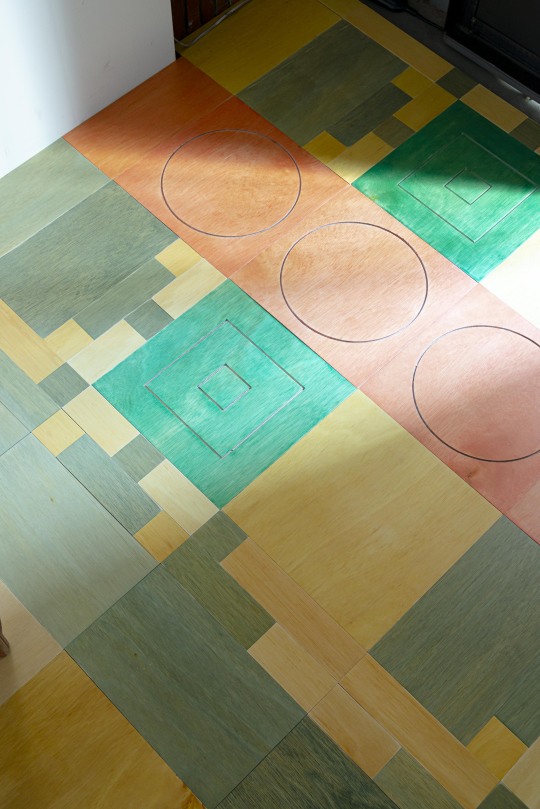
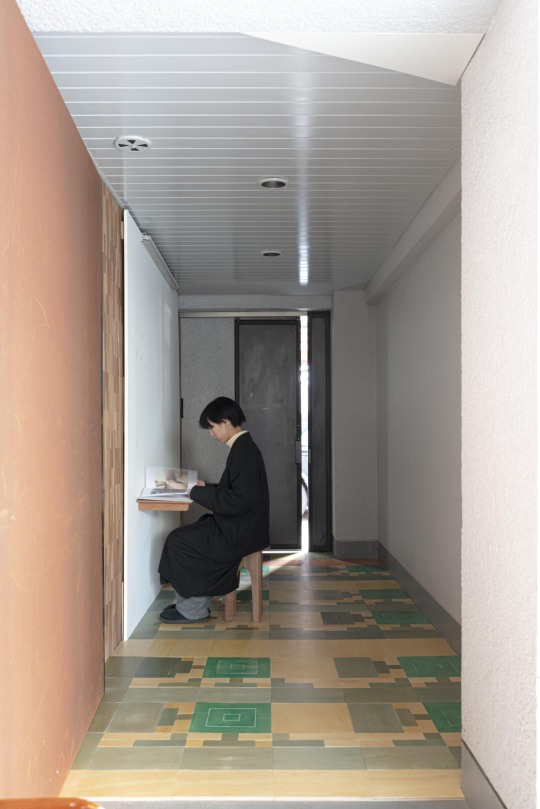

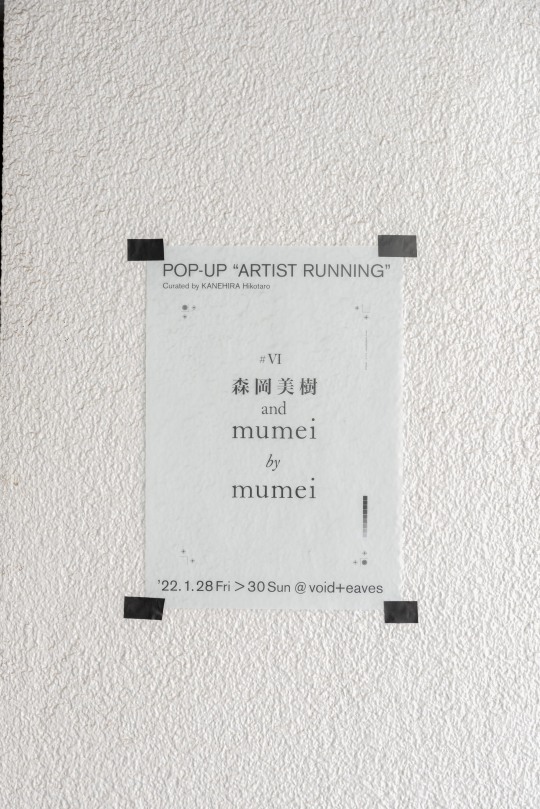

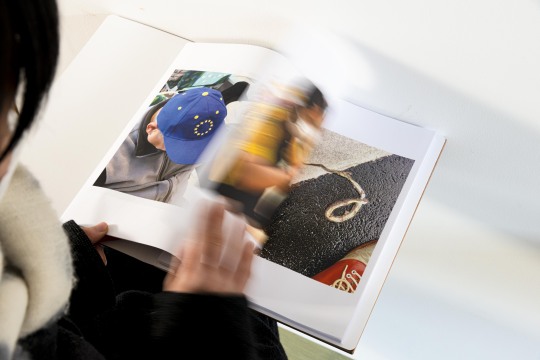
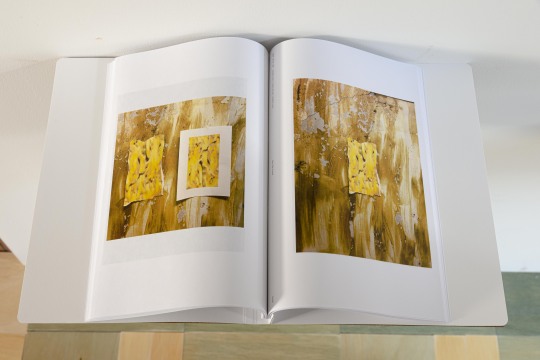
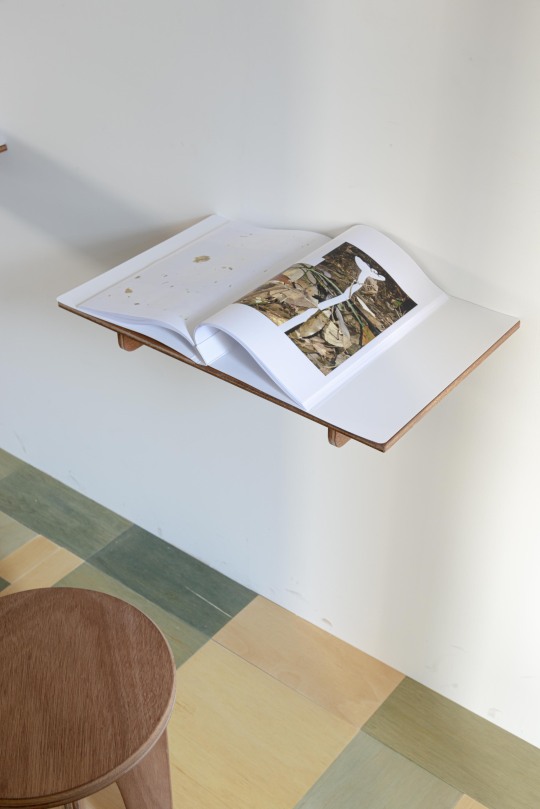
void+eaves POP-UP “ARTIST RUNNING” #6 Miki Morioka and mumei by mumei 2022.1.28 (fri) ― 30 (sun)
void+eavesでは、1月28日(金)から30日(日)まで、POP-UP “ARTIST RUNNING”の第6弾としてmumeiを招聘し、「Miki Morioka and mumei by mumei」を開催いたします。
POP-UP “ARTIST RUNNING”は、美術館やコマーシャル・ギャラリーといった既存のシステムに依らず、独自の方法やネットワークで活動領域を広げていくアーティスト・ラン・スペースやアーティスト・ラン・プロジェクトにスポットをあて、その活動をポップアップ形式で継続的に紹介していくプログラムです。
本プログラムの#6としてプレゼンテーションを行なうmumeiは、2017年に村田冬実により設立され、江東区の元相撲部屋兼宿舎を使ったアーティストのシェアスタジオをベースに活動を開始しました。2020年からは特定のスペースを持たず、他のアーティスト・ラン・スペースでのキュレーションや展覧会としての出版物を企画しTokyo Art Book Fair 2021でローンチするなど、場所や空間、形式や形態に限定されないフレキシブルな活動を行なっています。
今回は昨年末に発行されたその展覧会としての出版物「New Clear Answer」を、同書の参加アーティストでもある森岡美樹の空間や人、モノとの関係性を示唆し環境的にアプローチするインスタレーションとともにvoid+eavesの実空間にリアライズさせる予定です。
同時開催としてPOP-UP “ARTIST RUNNING”#4としてプレゼンテーションを行なったim laborのディレクターでありアーティストでもある大谷透、杉原玲那の特別展示もひきつづき行なっております。この機会にあわせてご高覧いただけましたら幸いです。
-------------------------------------------------------------------------------------------
mumei https://fuyumimurata.com/mumei
森岡美樹/ Miki Morioka
コミュニケーションが生じる空間における人やモノなどの関係性についての興味をもとに、床や机など人間の生活のなかでつくられたモチーフを展開させるような作品などを制作している。
1989年 東京出身、東京在住 2015年 東京藝術大学 美術学部 美術学部 先端芸術表現科卒業 2018年 東京藝術大学大学院 美術研究科 先端芸術表現専攻 修士課程修了 2021年 「Artst Running Festival 2021 in Kyoto」(Soda、京都) 2020年 OPEN SITE 5「声になるまえ」(権瓶千尋との二人展、TOKAS本郷、東京) 2018年 第66回 東京藝術大学 卒業・修了作品展(東京藝術大学上野校地、東京) 2017年 「不貞寝の旗」(取手芸大食堂 ショーケース、茨城) 2016年 「ホーリーテンプルで豊かな屁」(キュレーション:泉太郎、としまミュージアム 東京) 2015年 CAMP8月展 小口奈緒実「祖母に聞く」× 森岡美樹「Transit」× 良知暁「question no.27」 CAMP7月展 小口奈緒実「look for a beautiful singing voice #unfinished ver.」× 森岡美樹 「エラーを待ちながら」(共にスタジオ・アウフヘーベン、東京) 「プレ・オープニングパーティー」(企画・小口奈緒美blanclass、神奈川) 「第63 回 東京藝術大学卒業・修了作品展 」(東京都美術館、東京) 2013年 「Delta 可能性の手触り」(Bank ART studio NYK 神奈川)
-------------------------------------------------------------------------------------------
■企画タイトル:POP-UP “ARTIST RUNNING”
■展覧会タイトル:POP-UP “ARTIST RUNNING” #6Miki Morioka and mumei by mumei ■会期:2022年1月28日(金)― 30日(日) 12:00-18:00
■会場:void+eaves (東京都港区南青山3-16-14)
■ディレクション:杉原寛 ■キュレーション:兼平彦太郎 ■広報協力:YN Associates
-------------------------------------------------------------------------------------------
POP-UP “ARTIST RUNNING”について
国内のアーティスト・ラン・スペースを月替わりのポップアップ形式で紹介するプロジェクト。詳しくはこちらのサイトをご覧ください。
-------------------------------------------------------------------------------------------
【ご来廊時のご協力について】
*必ずマスク着用の上、受付にて手指の除菌をお願い致します。 *万が一関係者などから新型コロナウイルス感染症の発症があった場合に連絡を差し上げられるよう、ご連絡先の記入をお願い致します。 *発熱、頭痛、咳、倦怠感など体調のすぐれないお客様はご来廊をお控えいただくようお願い致します。 *展示室内の密集を避けるため、入場制限を行う場合がございます。
#pop-up artist running#void+eaves#void+#Hikotaro kanehira#mumei#miki morioka#artist run space#artist run project#exhibition
0 notes
Text
映らない記憶 / Utsuranai Kioku (Shimotsuki Haruka / Remlerose no Majo) romaji + traduction FR

Titre : Utsuranai Kioku ( 映らない記憶 ) Artiste: Shimotsuki Haruka ( 霜月はるか ) Album: Remlerose no Majo (レムルローズの魔女)
目を覚ましても未だ夢を見ている (微睡むように) この暗い部屋 居心地よく (閉じ込められて) 燭台(ひ)を灯したら広がる世界には (光の中) 要らないものが沢山ある (影は伸びる) Me wo samashite mo mada yume wo mite iru (madoromu you ni) Kono kurai heya igokochi yoku (Tojikomerarete) Hi wo tomoshitara hirogaru sekai ni wa (Hikari no naka) Iranai mono ga takusan aru (Kage ga nobiru)
Même si j’ouvre les yeux, je suis toujours dans un rêve (Comme un rêve éveillé) Cette chambre sombre m’est confortable (J’y suis enfermée) Lorsque j’allume le chandelier, le monde s’agrandit (Dans la lumière) Je possède un tas de choses inutiles (les ombres s’étirent)
空(から)の花瓶 埃を被る椅子 (…古い鍵) 針の止まる時計と破れた書物(ほん) 映らないキョウダイ Kara no kabin Hokori wo kaburu isu (...furui kagi) Hari no tomaru tokei to yabureta hon Utsuranai kyoudai
Un vase vide Une chaise poussiéreuse (...des vieilles clés) Une horloge aux aiguilles arrêtées, un livre déchiré Un miroir qui ne reflète pas
がらくたばかり集めていたのかしら…? 欠けた記憶のままでは外へ出られない ようこそ 硝子の城(ここ)へ訪れたお客様 銀の剣を片手に私を殺すの? Garakuta bakari atsumete ita no kashira ... ? Kaketa kioku no mama de wa soto e derarenai Youkoso koko e otozureta okyaku-sama Gin no tsurugi wo katate ni watashi wo korosu no ?
Aurais-je passé mon temps à amasser des vieilles babioles...? J’aurais bien du mal à sortir dehors avec une mémoire aussi incomplète Bienvenue, cher visiteur qui s’est arrêté en ces lieux Cette épée que tu portes d’une main, est-elle là pour m’achever ?
私の名前はアンダルシア この部屋で誰かを待ってる ひとりきりでも寂しくないわ 黒猫(ノワール)が私の友達 Watashi no namae wa ANDARUSHIA Kono heya de dareka wo matteru Hitori kiri de mo samishikunai wa NOWAARU ga watashi no tomodachi
Je m’appelle Andalucia Je suis dans ma chambre en attendant quelqu’un Il n’y a personne d’autre mais je ne me sens pas seule Mon ami Noir est là.
――何処カデ聞イタ声 ――瞳ハ朱イ月 ――私ト同ジ顔 ――アナタハ誰? -- DOKO KA DE KIITA KOE -- HITOMI WA AKAI TSUKI -- WATASHI TO ONAJI KAO -- ANATA WA DARE ?
-- J’ai déjà entendu cette voix quelque part -- Les yeux du même rouge que la lune -- Tu as le même visage que moi -- Qui es-tu ?
ふたりで眠る場所くらいある筈よ もしも故郷(いえ)に帰れても未来(あした)が無いなら Futari de nemuru basho kurai aru hazu yo Moshimo ie ni kaerete mo ashita ga nai nara
Il doit bien exister quelque part où nous pourront reposer ensemble Quand bien même tu parviens à rentrer chez toi, s’il n’y a pas d’avenir...
いちばん好きな薔薇を摘んでもいいわ 最期の日まで一緒と誓った貴方は 私の記憶ひとつずつ紐解いて 銀の剣を手にする誰かに、似ていた… Ichiban suki na bara wo tsunde mo ii wa Saigo no hi made issho to chikatta anata wa Watashi no kioku hitotsu zutsu himo toite Gin no tsurugi wo te ni suru dareka ni, nite ita...
Tu as le droit de cueillir la rose que tu préfères Toi qui as juré de rester avec moi jusqu’au dernier jour Déroulant petit à petit le fil de mes souvenirs Tu ressemblais tant à cette personne ayant pris en main une épée d’argent...
1 note
·
View note
Text
[翻譯] 紐約之王 ”JA ONE” (上+中)

如果您瞭解塗鴉中Bombing的文化,你不能不知道JA這個當時在紐約惡名昭彰的人物。在塗鴉創作的領域中,個性反應出這個名字出現在街頭的作風。
有些人喜歡獨自完成完整的大作,或是和朋友合力創作。有些人則喜歡在半夜行動,讓白天上班的人們能夠看到他們的名字。而在80年代的紐約,由於當局對待塗鴉著政策強硬,出現了更多Bomber,這反而讓局面更是一發不可收拾。
就如同現今的虛擬遊戲一般,當時塗鴉也是讓人沈溺其中的遊戲,遊戲一定少不了瘋狂玩家—他們用盡生命的一切投入在這個遊戲當中,無法自拔,甚至分不清現實與虛擬。
JA便是當時家喻戶曉的玩家之一。
所謂Bombers-也就是數量甚於質量的塗鴉者 - 他們的名字不會出現在塗鴉書籍那些漂亮的Piece之中(較為完整的圖),原因很簡單,這種塗鴉的散播方式和影響力,可不會只是在那些精美的出版書籍裏,而是讓你無處不見。
曼哈頓Writer(塗鴉人自稱”寫手”而非藝術家)”JA ONE”的名字是隨處可見在紐約:從曼哈頓的上東區到各區,他一次行動便十分密集,Tag寫遍各個鐵門和小巷。
塗鴉人KET表示:” JA 至今在紐約仍是無可爭議的King of bombing,他的努力不懈讓他這個名號從80年代末跨越至今二十多年,他的名字會出現在火車、火車站、高速公路,各個街角,還有....任何你想像得到的地方。他的Tag從Bronx到Brooklyn就像是吸了染料的布一般的滲透在各個角落。
他的職業生涯之所以能夠一直繼續,因為他熱愛街頭創作,並且對塗鴉保持十足的熱情,這足以保留塗鴉最原始的遊戲規則。
許多的Writer在塗鴉生涯中通常都有些夥伴,而JA已經有非常多了,他們會不斷塗鴉直到他們某天對那不斷的”深夜任務”感到疲倦的時候,他早已經招收和培養了下一代的Bombers。
只能說:“那傢伙的狂熱,誰也擋不了”
----
以下大略節錄一些滾石雜誌對JA 1995年二月的訪問:
“第一次和JA見面,他穿著溜冰鞋向我這邊溜過來,把帽子反戴,在曼哈頓的午夜街頭。 他是個24歲的白人,精壯身材和金色的小平頭。他在紐約斷斷續續的塗鴉也將近十年,他也是團體”XTC“的創始人。他的頭皮、手臂、胳臂有著各式的警棍疤痕,鐵絲網、拳頭、各種尖銳、鋸齒狀的東西都有可能在越過牆壁之後等著他。他稱被警察毆打就像被用木棍洗頭一般。當他出手塗鴉時,發生過從高速公路號誌跌落到行駛的車上、裸奔到火車調度場Tag、被塗鴉對手拿著高爾夫球桿追到高速公路上,並冒著生命危險無數次去Writing、Bombing。

JA獨自一人住在公寓套房,長鏡上滿是塗鴉,桌上是磅秤和熔岩燈,噴漆罐放在角落,有一張MTA(紐約交通管理局)的大貼紙貼在冰箱側邊,電鈴旁邊的名字是個假名,他的電話號碼是不公開的,以避免執法人士和其他塗鴉對手的關切。雖然JA和他的塗鴉夥伴JD是冒著被逮捕的風險接受採訪。
在JA的公寓裡頭我們抱著期待的心情看著那些數以百計的塗鴉照片,照片中的Writer們冒充公家機關的員工,穿著橙色背心,把地鐵車廂整台完全的用Tag覆蓋,以及步行地鐵軌道的照片。
某張照片中的警探和運輸局人員正發現了一個前一晚JA和他的團隊畫了一些很具風格的”JA“Throwup塗鴉,大約五十個高十五英呎的大泡泡字,跨越高速公路的擋土牆。
之後的照片還有JA在火車上、卡車上、或是商店大門、橋上、屋頂、廣告看板---一切都記錄在相機膠卷內。


JA來自一個小康家庭;他的父母離婚;而他的父親在娛樂圈有高度聲望。JA意識到其實一些人會質疑他所做的事,他已經投入了大量精力在鑽這些法律漏洞。他估計他已經在各種罪名之下被逮捕十五次。他沒有工作,而且目前也不知道該如何支持自己的生活,每次當我們在一起時,他不是已經嗑High,就是正要去High。有一次他在賴克斯島監獄打電話給我,他說裡面一些服刑人員看到他正Taggin在筆記本上,便問他能不能幫他們在身體刺上這些圖案。
這聽起來沒錯,不管他本人是誰,JA這個身份名氣甚巨,主宰了他生活周遭的一切,當我問某個城市的警探在打擊塗鴉時,有哪些Writers是特別著名的,他馬上提到JA,並且有點驕傲的說:”我們互相認識。”他稱JA是有史以來最著名的塗鴉者(但我寧願警探沒有提到他,這似乎只會更助長JA的威風),警探這麼說:”他有最多的Throwup在這個城市,這個國家,這個世界!如果平均一個大咖塗鴉人有10000個Tag,那JA大概有100000個,他真的做到了---光是在紐約市可能就製造了近500萬美元的損失。

行動紀錄
大約凌晨三點,JA和其他兩個塗鴉夥伴外出轟炸了一個位於哈林西城區公路旁的廣告招牌。今晚的兩個夥伴:一名是21歲來自紐約皇后區的白人Writer”SET”,以及一名同歲,同樣來自皇后區的拉丁美洲Writer ”JD”。他們把Rust-oleum的噴漆罐鏮啷作響的放入背包,帶了Fat噴頭,工業用斷線鉗和手術用手套。 我們擠進一輛車開始行動,電台正在大聲播放饒舌歌手Schooly D的歌。第一站是停在熟食店,JA和SET其實是要去偷啤酒。
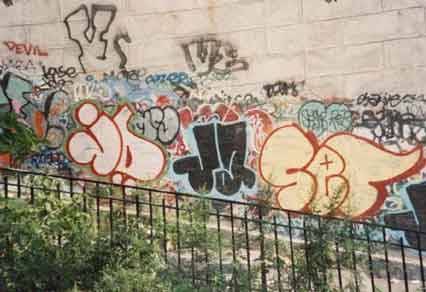

然後我們在哈林區遊晃,嘗試了一些不錯的塗鴉點,在保持警戒的狀態中一眼撇到了台警車。
JA把喝完的40-ounce(瓶裝啤酒)扔出車窗外,拋物線高高的,瓶子摔破在街上。(註:珍惜生命,絕不酒駕)
前往另一個地點,JA走出車外,從容的走在街上,進入建築物找藥販子。塗鴉生活絕大部份是在各種奇怪的時間,出現在城市中遊走,而且毫無畏懼---(或是有所畏懼,但依然塗鴉。)
我們去了一個地方,一去就見到JA已經把那藥頭的名字TAG在他的地盤上。
這三個Writer買了一小瓶快克和天使粉,並結合他們變成”spacebase”放入挖空的Phillies blunt雪茄裏。 JD告訴我說某些藥物會增強你的Bombin能力,因為它們會給你勇氣和力量(生物學原理@@?)。他們還用了麥司卡林、安定藥、大麻、快克和麥芽酒。SET說了他們清晨六點爬到高速公路上塗鴉的事,故事的當時大家都嗑了贊安諾。
(註:藥物請配合藥師處方使用)
當JD準備著雪茄,JA已經走到對面,並把他們三個人的名字Throw up了一個4英尺高的泡泡字。在角落裡也寫上了我的名字。
然後我們又開車到郊區的海濱,有一個廢棄的倉庫,鐵路軌道,在空曠的視野有幾個高聳的廣告牌。這三個Writer已經嗑到ㄎㄧㄤ掉了,我們坐在車外面抽菸。
從遠處看到幾個男人,在裝卸碼頭附近的拖車鬼祟走動,那原本是我們的目標,這引發了30分鐘的”塗鴉強迫症”,ㄎㄧㄤ掉的三人進行了”實況報導“:
SET:「老兄,他們是Writer~」
JD:「我們來去看看他們在幹麻」
JA:「等等,讓我看看他們畫什麼」
SET:「Yo~~他們跑到卡車裡了」
JA:「噴漆罐,老兄,他們為了噴漆罐,老兄,他們是Writer」「這裏會有些Beef,一定有Beef」
SET:「我們可以證明有噴漆罐?我們有看到噴漆?」「有噴漆罐~他們是Writer~」(自問自答)
原來那幾個人只是偷卡車東西的小偷,在幾分鐘後警衛帶著槍和手電筒出現,小頭分頭逃竄,只聽見警犬的汪汪聲。
我們等待多時的這刻終於來臨,當JA宣布行動開始,蓋上帽T的帽子,他帶領我們穿過樹林匍匐前進(這對他而言可能已經變成電影裡面的越南叢林....),他走走停停,彎著腰無謂的靠近警衛再閃開。我們通過一個滿是塗鴉的小隧道(伴隨著電影一定會出現的水滴畫面...),在搖搖欲墜的梯子上長滿了雜草和藤蔓,沿著黑暗,我正和跟幾個嗑藥的人在雜亂的小徑之中闖蕩。
我們接近了廣告招牌,JA使用斷線鉗切斷柵欄孔,我們爬過去沿著鐵軌走,直到到達了看板下的地基。JA背著背包,攀登上大約40英尺的金屬支柱,JD幾經嘗試,跟著JA,並遞了斷線鉗給他,JA懸在半空中,雙腿纏在梯子上切斷了掛鎖,他打開了門走到看板旁邊的側邊小走道,接著他把手臂給了還在下面掙扎的JD。
「JD,給我你的手,我會拉你起來。」JD猶豫了,他不願放手,企圖繼續抓著桿子網上。「JD,給我你的手」 JD並不想拒絕,但他不信任把他的生命交付給JA,他不想放開桿子。 JA又堅定、從容、有信心的說「JD,給我你的手」,JD的手臂勾到了,JA把他拉上看板的側邊走道。
接下來是SET,三人之中最俗辣的,在下面邊發抖邊搖晃著,其他兩人已經叫他下去,他們會幫他TAG在上面,但他還是堅持往上走邊說「哥們,馬的,我好俗辣」,我不敢繼續看,總覺得他這個搖晃的狀態爬上去,肯定會摔下來(他確實有兩次快掉下來了)。這三個人計畫了一個模式,當一個Writer畫Outline時,另一些人就接在他後面填色。大約四十分鐘的時間,他們拼命的塗鴉,把議會和鐵路公司的廣告蓋上了五顏六色的Throwie,SET和JD在上面為了塗鴉的位置爭吵,JA很生氣的罵了他們,還丟下空罐子。
臉上沾滿顏料的他們再度冒著生命危險爬下來。三人的眼神始終聚焦在廣告招牌上「是不是很漂亮?」,他們問。
這些迷人的事情是無法藉由訪問形容,只能親身體會,一個乾淨的目標物,變成了五顏六色。我們鑽進車裡,駛向西城公路,先往北走再繞回往南,為了要看剛剛的成果,這樣他們就能檢討他們的”大作”了。 「馬的,我剛應該用白色」JD這麼說。
第二天,兩個廣告看板都被重新覆蓋了,所有的塗鴉完全消失。JA告訴我他們三個在稍早有回去拍照,還和清理塗鴉的工人閒聊了一會。

(未完待續....)
“JA”和”DAST”的看板Throwup
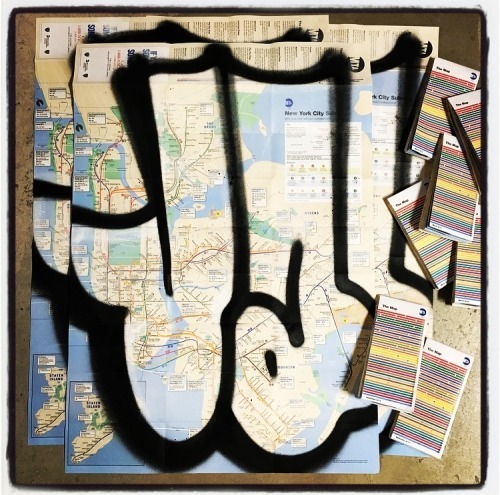
近年仍在販售的JA周邊,一些被塗鴉的紐約地鐵系統圖。
—
(續上集)節錄 滾石雜誌對JA 1995年二月的訪問:
街頭塗鴉在70年代初期,透過一個希臘少年-Taki183而蔚為風行,Tag(塗鴉的特殊用語,意指簽名)從一開始簡單的書寫個人暱稱,到後來演變成具強烈的風格,甚至難以辨識。延伸出Wild-style (狂野風格) Throw-ups (拋擲塗鴉,一詞亦有嘔吐之意。)、以及各種精心製作的Piece (較為完整的圖,為Master-piece的縮寫)。再加上原本在街頭就經常看到的一些隨手寫在牆上的種族主義文章、暗示販毒的小廣告、以及幫派塗鴉。而塗鴉藝術圈有著明的Keith Haring(凱斯哈林)、 Jean-Michel Basquiat (米歇爾巴斯奎特)。以及LEE (隸屬於經典團體The Fab5,曾出演電影Wildstyle)、Futura 2000(早期塗鴉藝術家,跨足塗鴉、藝術、設計等領域)、Lady Pink(隸屬於經典團體TC5,也曾在電影Wildstyle中演出)等人出現。
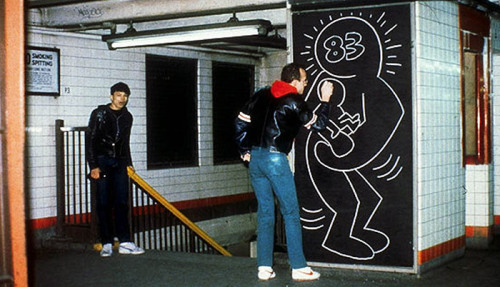
在地鐵作畫的Keith Haring。
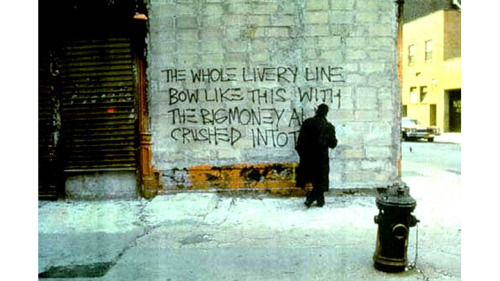
Jean-Michel Basquiat在街頭書寫以SAMO為名的塗鴉。
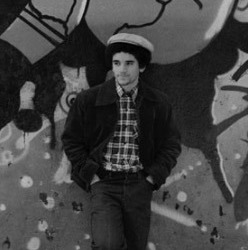
隸屬於The Fab5的LEE,當時和Lady pink是一對情侶。
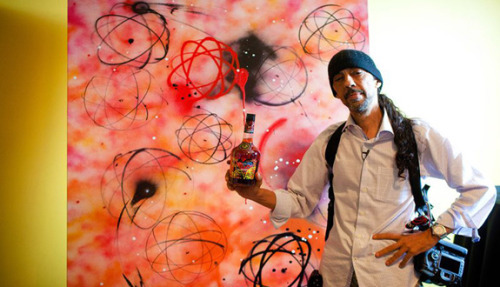
Futura 2000近代使用他的獨特符號持續創作。

當時也有出演Wildstyle的Lady Pink。
—

JA在卡車上的Throw-ups
—
噴罐廣告、塗鴉電腦繪圖、防塗鴉的廣告牌、貼紙以及模板形式的塗鴉。舊金山的藝術學院學生(Brett Cook)也開始製作未經申請的的公共藝術企劃、紐約的地下道新作品持續增加著;塗鴉在畫廊展覽,從科羅拉多州到新澤西;並有塗鴉藝術家在大學講授藝術相關課程。塗鴉已經成為城市文化、嘻哈文化、以及商業文化的一部份,此時已經蔓延到郊區,可以在加州國家森林的偏遠地區被發現。有塗鴉雜誌、塗鴉店、受委託的塗鴉牆面、塗鴉名人牆(walls of fame),將塗鴉行動剪接並加入配樂、製作成紀錄片(Out to bomb)。70年代是塗鴉最風光的全盛時期(Norman Mailer's的攝影集"The Faith of Graffiti");甚至登場在上個世紀的好萊屋(Beat Street, Turk182!, Wild style);90年代政府積極的處理之下,塗鴉已經消聲匿蹤於城內,70年代成為人們緬懷的過往,只存在於記憶之中。
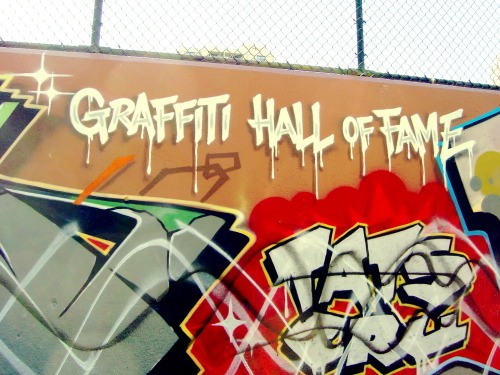
位在紐約哈林區的Graffiti wall of fame,已成為一個遊覽的觀光景點。
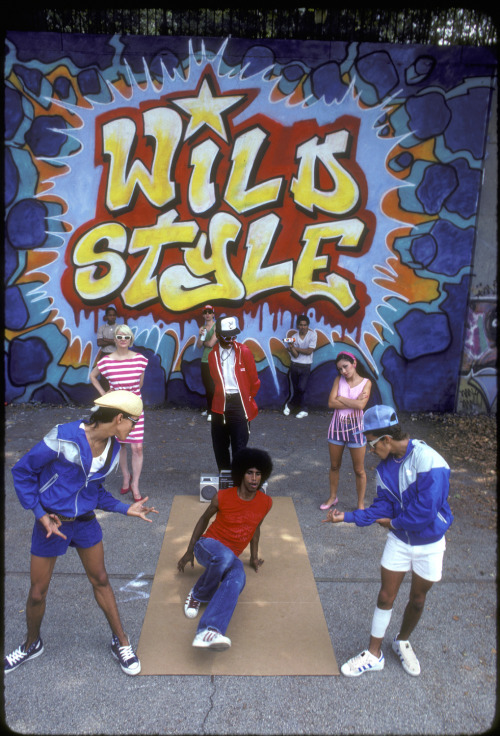
當時還有幾部以塗鴉為主題之一的電影。
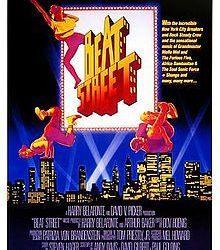
Wildstyle、Beatstreet都有帶到當時Hiphop文化的樣貌,雖然因為劇情需要還是有許多誇張的成分。

TURK182就較以商業劇情為內容。
—-
雖然塗鴉已經開始在某些場合被接受,但給人的惡形象仍然根深蒂固。Writer們現在開始被判以重罪,並提高了刑期時數。一個15歲的青少年被判處在青少年拘留中心八年的刑期。也有可能被判處高達1000小時的社區服務,並被迫接受多年的心理輔導。他們的父母也有可能被卷入民事訴訟。
在加州的塗鴉人,可以處以吊銷駕照一年;高中畢業證書和成績證明也會被扣留、直到家長作出賠償。在一些城市,即使是私有財產上有塗鴉,不配合清除的話也有可能面對罰款或牢獄之災。
去年春天,在聖路易斯、辛辛那提、聖安東尼奧以及沙加緬度和加州,甚至有政治家建議對塗鴉人處以杖刑(類似鞭刑,一次處以四到十仗,由法警或父母在法庭上公開監督)。
並且全國已立法通過,不得出售噴漆和寬頭麥克筆給未成年者,並且將其鎖在櫥櫃中。 幾個城市都試圖禁止噴漆在大賣場銷售,取得許可銷售的店家要要求在購買噴漆時,留下他們的姓名地址資料。
在紐約,一些五金店老闆會拍下購買大量噴漆的人給警察。在芝加哥有人因為私藏噴漆被指控。在加州的San Jose,有臥底警察冒充成塗鴉紀錄片的製作人,逮捕了31名Writer。
隱藏攝影機、運動探測機、雷射感應、特殊塗料、夜視鏡、鐵絲網、護衛犬、全國塗鴉資訊網路、塗鴉通報熱線、支付檢舉人的賞金——有人估計每年花費40億美元在全國清理塗鴉——

當時的紐約有犯罪之都的稱號。
—
廣為流傳的是大約1980年代末期,紐約當局對塗鴉實施零容忍政策:紐約運輸局一次清除或銷毀超過六千個覆蓋地鐵的塗鴉車廂,要是有任何車廂遭塗鴉便立即停止運行,不會讓他開出機房。塗鴉文化就此消失在它誕生的地方。
但儘管紐約運輸局企圖消滅塗鴉,也只能將塗鴉趕出隧道和列車車廂。或者正如記錄了丹佛塗鴉現象的犯罪學家Jeff Ferrell所提出的理論,當局鎮壓使得塗鴉從小眾的次文化,成為了反主流社會的反文化。塗鴉人不再以車廂為目標了,便開始打街頭游擊。在開放空間塗鴉,他們不得不用更快、更頻繁的方式作畫。
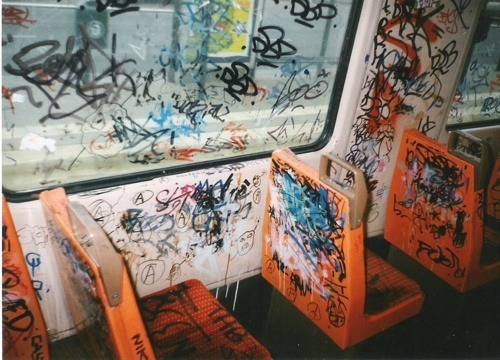
無法畫大型塗鴉,只好開始Tag。
—
美觀的塗鴉開始越來越少。Throw-ups、用麥克筆在隱密之處寫的小Tag、簡單的塗鴉方式佔了優勢。量多大於品質(重要的是要引人關注,"Making noise!“),這是一場真實的遊戲。塗鴉的世界開始吸引越來越多的人,他們並不是要尋找可以取代畫布的牆面,他們只是想連結到一個在體制外,有歷史文化、街頭規則的社群,在這裡面允許他們宣傳自己的一套心聲,表達他們的反抗、挑釁。
JA說:"你如果認為,辛苦完成一張作品,但不是每個人都看得到也沒關係“是啊,這樣想是不錯啦,但你的動力如果僅止於此,可能很快就會停止塗鴉,這發生在很多塗鴉人身上。
JD和我說:我們要把圖直接放到他們眼前,就像畫在他們臉上一樣,叫他們忍忍吧!
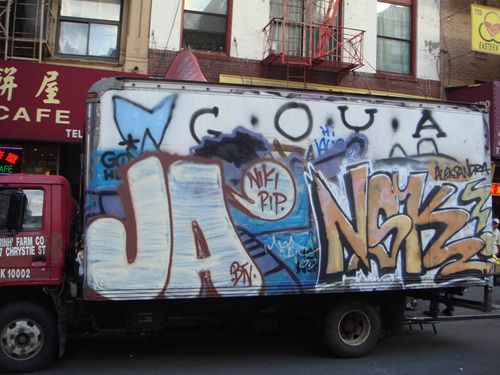
報紙現在已經將其定義為"graffiti vandal” (塗鴉破壞者),而不是Artist或是Writer。隨意的塗鴉招致了他們的成就瓦解。近年來塗鴉越來越多牛肉和戰爭,不是戰爭議題,而是關於"fucking up MTA(紐約運輸局)、fucking up the city"之類的黑特。 Writer們開始奮起、行動,有如士兵般的強悍態度。開始在高難度的地方Taggin,並強硬的蓋過它團Writer的作品,並捍衛自己的團體。(“If you can write, you can fight”)
塗鴉一度被認為是街頭生活之中的另一樣不同選擇,但現在運毒、暴力、槍械和竊盜充滿了那個世界。
塗鴉的定位,成為了”浪漫的犯罪者”,而不是”非法的藝術家”。
今日的紐約,根據警方估計,大約有十萬多人參與了各種塗鴉行動。警察逮捕到的Writer最年輕的八歲,至最年長的四十二歲。並有一小群鐵桿玩家,是來自塗鴉最興盛的時期,即使日漸年長,已不是當年的小伙子,依然充滿狂熱。即使政府當局不斷打擊,他們在現實生活之中,還沒有其他事物能夠讓他們能像對塗鴉一般的狂熱。
20多歲的Writer大部分來自勞動階級家庭,對自己的未來和前景通常較沒有企圖心。SET在一間藥店工作,因為憂鬱症,偶而會使用鋰鹽和百憂解。JD高中便輟學,並處於失業狀態,上一個工作是信差。他們晚上以時速80英里奔馳在城市公路,40盎司的Old-English 800(當時流行的瓶裝麥芽酒)空瓶在他們的雙腿間滾動,煙霧瀰漫來自混著快克的煙叫做coolies���電台不斷在播放,他們不斷在懷念過往,當時塗鴉的全盛時期、當塗鴉在火車上跑的時候,他們交換他們當時在現場的故事,還有一些ㄎㄧㄤ話。



SET、JD。
—
他們攜帶傳呼機,有時會有槍械,去北部或長島鄉野狩獵,打噴漆罐子。談論著即將到來的訴訟案件和緩刑,時而萌生退意。但只要他們有新的地點能塗鴉、在公寓的牆上練習他們的新風格,寫在食物的包裝,或是任何散落的紙張上(年輕的Writer們在學校都在筆記本上練習塗鴉,如果老師發現是可以移交警察處理的。)還有這樣的一天,他們的生活就離不開彼此。
他們稱塗鴉為"社交工具",或是某種(較不健康)的通信系統。是指每一個Writer,無論年齡歲數。塗鴉的生活讓他們的定位在平凡人和傳奇人物之中搖擺不定,就像這個活動本身:數小時的苦工、聚會、等待、以及一些意外的插曲。JD回應塗鴉的感覺:塗鴉人就像個婊子般,說很多謊、很多八卦、很多廢話。他們不喜歡Taggin時被女生圍繞,因為他們只會抱怨"你瘋了嗎、好誇張、能寫我的名字嗎…“
當JA談到塗鴉,他不願提供任何關於這個塗鴉的信息給媒體(雖然他知道很多)。他更喜歡說的是”Fuck the graffiti world“,並對現在的塗鴉商店、塗鴉影片和塗鴉刊物嗤之以鼻。但他可以多愁善感的形容他是怎麼開始塗鴉的。 在他年輕的時候搭乘1、2、3號列車,看見那些被塗鴉轟炸過後的車廂。他自問:他們是怎麼做到的?他們是誰? 他尊敬並讚美那些以前的Writer,像是SKEME、ZEPHYR、REVOLT、MIN。

SKEME

ZEPHYR

DEVOLT和Henry Chalfant
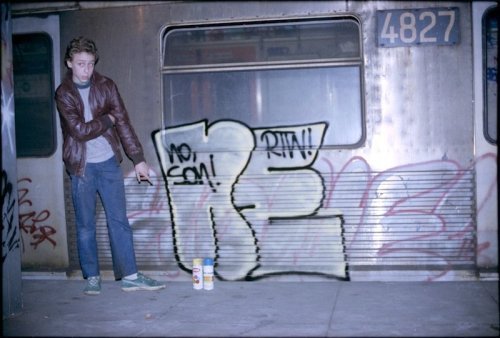
80年代的Min one (aka NE)
—
JA、典型的new school玩家(當時),用Throw-up的形式bombin覆蓋非常大的面積。 他不把塗鴉當成是個藝術形式,比較像體育競賽。他集中火力Taggin在難以到達的地方,並絕對性的注重數量大於美感,這點迫使著公家機關一定會清除他的塗鴉(塗鴉人幾乎都是畫在公共或是商業區域)
當JA不那麼憤世忌俗的時候,他可以談論有關塗鴉的技術、繪圖、計畫等等,關於這個遊戲的內容。就像是顆上了發條的定時炸彈一般,他知道列車停靠的時間和地點,以及火車通過隧道的信號。JA說到:”對我來說,每當挑戰塗鴉的高難度,對我的精神而言是種振奮以及釋放,這是關乎精神層面的事。它能給予我們的快感超越任何一種藥物或是性愛。真的。“
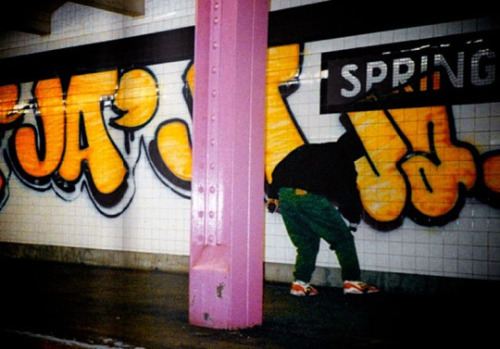
最終話待續.......
MESS-AGE TAIWAN
聯絡我們 : [email protected]
Instagram : mess_age_taiwan
Facebook : Mess-Age
10 notes
·
View notes
Photo

#原宿カワイイ展 デザインフェスタギャラリー原宿さま @designfestagallery 振悶亭めこ さま @full_mon69 のブース 。 瓶なパッケージに、すっぽりな、かわいこちゃんの原画や レトロキッチュキュートなブレスレット、ネックレス、 プチプラのアクセサリーも なかなか他の場所では見かけない、可愛くて、遊び心をくすぐられる楽しいデザイン! 。 カワイイだけじゃない、ちょっとえっちな狐さんたち、かわいこちゃんの原画沢山ありました! 展示されている空間も、なんとも可愛くてたまらなかったです! 。 デザインフェスタギャラリー原宿 EAST #原宿カワイイ展 28日 明日まで! #art #artist #exhibition #event #cute #kawaii #purity #dfgharajuku #harajuku #アート #展示 #イベント #原宿 #デザインフェスタギャラリー原宿 #カワイイ #かわいい #キュート #原画 #イラスト #イラストレーション #illustration #アクセサリー #プチプラ #作品 #ハンドメイド (デザインフェスタギャラリー Design Festa Gallery) https://www.instagram.com/p/B26EA_YlQD0/?igshid=19eqsodo47qaa
#原宿カワイイ展#art#artist#exhibition#event#cute#kawaii#purity#dfgharajuku#harajuku#アート#展示#イベント#原宿#デザインフェスタギャラリー原宿#カワイイ#かわいい#キュート#原画#イラスト#イラストレーション#illustration#アクセサリー#プチプラ#作品#ハンドメイド
1 note
·
View note
Text
哲学早餐俱乐部与第三种文化
1817 年,作为诗人的柯勒律治还会写书讨论科学方法,这在当时都不算奇怪。到了 1833 年「科学家」一词出现之后,诗人谈论科学就已经很少见了。1833 年之后,这种「跨界」几乎就是难以想象的了。再到后来,艺术和科学之间慢慢建起了一道围墙,迄今为止,这道围墙依然矗立。
作者:张文武 2017年10月24日
人文与科学的对立
1977年恢复高考以后,中国大陆学校开始实行文理分科制,于是就有了一个有趣的现象:越往高处走,课程的范围越窄。高中分科前,文理都要学,所有学生都一样;分科后,文理科学生的课程开始不一样了;进入大学,有了「专业」,范围进一步收缩,不同专业间的差异更大了;到了研究生阶段,「专业」进一步细化,变成了「研究方向」。我们通常所说的「博士」,或许可以改名叫「渊士」,因为其学习研究注重的是「渊」,而不是「博」。
从低到高不断收缩课程范围的做法,说到底是为了向社会输送专业化的人才。在一个凡事讲求「效率」的世界,对专业化的重视是一件好事。但世界未必只为「效率」而存在,况且,短期而言「高效」的事情,长期来看未必「高效」。
一百年来,到底是打造专才,还是打造通才,已经成了东西方共同的世纪命题、「百年战争」。五四时期,德先生(属于人文阵营)与赛先生这两面旗帜还同等重要;但没过几年,一场「科玄论战」,在人文和社科之间撕开了裂缝。这场论战根源于张君劢1923年2月14日在清华的演讲《人生观》,指出科学与人生观的区别,并对「科学万能」的论调进行了批评。演讲发表后,地质学家丁文江发长文反驳张君劢,斥其为「玄学鬼」。随后,胡适和梁启超也分别加入了科学与玄学的阵营。胡适讽张君劢为孙悟空,逃不出科学和逻辑这个如来佛的掌心。梁启超虽然支持玄学派,但对科玄两派都给予了一定的批评,他认为有些问题可以用科学来解决,有些问题是超科学的,只能从心灵层面去解决。
两种文化
几十年后,英国人C.P.斯诺开启了西方的「科玄论战」。斯诺既是物理学家,也是小说家,称得上是文理兼修的通才。他常参加一些所谓高知分子的聚会,发现这些人很喜欢嘲笑科学家「文盲」。他实在气不过,就质问对方:「你们当中有几个人知道热力学第二定律是讲啥的?」斯诺认为,向这些人提这个问题,就相当于问科学家:「你读过莎士比亚吗?」
斯诺说,西方世界最聪明的那群人对现代物理学的了解,跟新石器人类没什么差别。即便是向人文学科里的这些高知分子提一个更简单的问题,比如什么是「质量」,或者什么是「加速度」,恐怕也只有十分之一的人能答出来。不过,如果向科学家问:「你读书吗?」估计也是一样的结果。
针对这种现象,1956年,斯诺在《新政治家》杂志(New Statesman)上发表了文章《两种文化》(The Two Cultures)。1959年,斯诺进一步扩充自己的思想,在剑桥大学做了著名的演讲《两种文化与科学革命》(The Two Cultures and the Scientific Revolution),随后依次为题出版了一本书。除了指出问题所在,他还提出了解决之道:用第三种文化调和「水火不容」的两种文化。2008年,《泰晤士报文学增刊》(The times literary supplement)把这本书列入二战后西方公共话题领域最具影响力的100本书。

C.P.斯诺
斯诺的思想在大西洋两岸引起了广泛讨论,两种文化命题也因此成了「斯诺命题」。为了响应相关的讨论,斯诺在1963年出版了《再谈两种文化》(《两种文化与科学革命》扩充版,The Two Cultures: And a Second Look: An Expanded Version of The Two Cultures and the Scientific Revolution)。[1]
这本书里,斯诺修正了原来的一些观点,对于调���两种文化的「第三种文化」是否会实现,他的态度也变得更为乐观。然而,几十年过去了,直到斯诺去世,人们似乎也没能看到第三种文化的曙光。
第三种文化
几十年后,在1995年《第三种文化》一书中,美国的约翰·布洛克曼(John Brockman)提出了新的理解:科学界人士要主动承担起科普的重任,消除两种文化之间的鸿沟。布洛克曼所代理的众多作家作品,似乎都可以看做是在践行这种理念。
有人觉得布洛克曼提出的「第三种文化」无非就是高级科普,这种看法倒也不无道理。而《失控》《必然》等畅销书的作者KK凯文·凯利,对第三种文化的理解似乎更有新意。
1998年,KK在《科学》杂志发表文章《第三种文化》。文章称,第三种文化是一种「从技术中来,到技术中去」的流行文化,可以叫它「讷客文化」(nerd culture)或者「书呆子文化」、「技术宅文化」。之所以这么说,是因为20世纪最后20年里,技术已经完全渗透到我们的人文环境里,你无法忽略它的存在。对于玩着任天堂长大的孩子来说,技术就是他们的文化。
KK认为,科学产生了真,艺术产生了美,而技术则产生了机遇:新的未知事物;新的表达方式;新的通讯工具,以及新的破坏手段。这些新奇的东西,构建不一样的了第三种文化。这种文化崇尚科学的严谨,但其目的又不是为了追求真理,而是为了追求新奇。和人文艺术一样,这种文化「以人为本」。在这样的第三种文化理念下,纯粹的真理没有意义,纯粹的表述也没有意义,只有真切的体验才是重要的。

KK凯文·凯利(Kevin Kelly)
与纯粹的科学和人文这两种文化不同,技术这种文化确实更为有机,它似乎天生就是为了弥合两种文化的鸿沟而存在。[2]
反观当下,KK口中的这种第三种文化似乎已经开始流行。以中国为例,总会有一些技术相关的图书会成为超级畅销书。线上线下的读书会,也常常会以技术趋势为话题展开深入讨论,而参加讨论的有很多都是文科生。这很像一百多年前两种文化还没分家时的情景。或者可以说:我们正在向着两种文化分家之前的世界回归。
讷客与自然哲学家
KK所描述的「讷客文化」,似乎在两百年就流行了。那时候有一群类似于「讷客」的人,不过他们爱好的不是技术,是科学。那时候,做科学研究的人被称为「科学人士」(man of science,因为当时很少有女性干这个),「学者」(savant,最初是法国人称呼博学之人的词),或者「自然哲学家」(natural philosopher,因为自古以来科学和哲学之间关系密切)。
在 19 世纪初,搞科学的人大都是乡村牧师这样的神职人员,他们有大把的闲暇时间用来收集甲虫和化石。一些富有的绅士喜欢搞科学,他们可以在自己花钱建的实验室里做实验。这些富人的杂务总管,也常常跟着搞科学,给老板打下手。那个时代,人文艺术和自然科学之间还没有鸿沟,两种文化有一个共同的名字:知识。
那时候「文艺复兴人」一样的通才并不少见。1817 年,著名诗人柯勒律治就写过一本有关科学方法的小册子,这在当时并不奇怪。不过,和柯勒律治一样,很多人认为「自然哲学家」仍然属于「形而上学」范畴。在科学方法上,人们注重的是理论以及理论的「演绎推理」,而不是事实和事实的归纳分析。

塞缪尔·泰勒·柯勒律治
与KK口中的「讷客」不同的是,那时候虽然有很多人热衷于探索未知,但这种探索仍然只是有钱人的个人爱好。社会从上到下,也鲜有对这种探索的支持和认可。科学界内部的交流,也存在很大的障碍。虽然那时候没有高墙横亘在人文与科学之间,但知识的传播却被别的高墙挡住了。
在《哲学早餐俱乐部》(The Philosophical Breakfast)一书中,美国科学史作家劳拉·J.斯奈德(Laura J. Snyder)有这样一段描述:
没有人会因为科学研究得到报酬;大学也极少支持化学教授的实验;在剑桥和牛津,学生甚至拿不到自然科学学位;科学创新得不到任何荣誉,也得不到贵族头衔,连金钱的奖励也没有。科学界,做研究的人很少聚在一起,他们从来不公开讨论自己的工作;就连伦敦皇家学会——从艾萨克·牛顿时代以来就是自然哲学的 堡垒,虽然也宣读科学论文,但从来不会对论文进行讨论或是反驳。事实 上,该学会的很多成员根本就不是科学人士,而是古文物研究者、文学人 士,或是想要同哲学家交往的贵族。 [3]
此外,科学一直是为国家服务的,为国王和政府服务的,很少有人认为科学应该用来提高普通人的生活。就这一点而言,也与「讷客文化」有着明显的区别。
科学就仿佛还是中世纪的炼金术,秘而不宣的方法,遮遮掩掩的发现,只有进行研究的人才能获得其中的好处,禁锢了知识。毫无疑问,这四人觉得科学是停滞不前的。
从上面的描述可以看出,科学虽然流行,但显然已经遭遇瓶颈,传统的「自然哲学」已经无法推动它进一步发展,科学从中脱胎而出另辟蹊径独立发展,是势在必行了。
「科学家」的诞生
1833年6月24日,「科学家」(scientist)这个词诞生了。
当天,英国科学促进协会在剑桥大学召开了第三次大会。很多人从英国各地乃至欧洲大陆和美国,前来参加会议。三十多岁的剑桥大学明星学霸威廉·休厄尔(William Whewell)上来致开幕辞,讨论了科学的现状,对科学的本质做了总结,指出「事实和理论」构成了科学,两者都很重要:要成功地进行科学研究,既要有明锐的观察力,又要有理性的推理能力。为此,他还特意提到了三一学院以前的一位成员——弗朗西斯·培根,17世纪的科学改革家,倡导科学人士用培根的理念来指导自己的工作。
开幕辞获得了如雷般的掌声。掌声沉寂之后,一位男子很狂妄地站了起来。他就是著名的浪漫主义诗人、曾在数十年前写书谈论科学方法的塞缪尔·泰勒·柯勒律治。此前的三十年,他几乎足不出户,但这一次,他觉得有必要不辞辛劳赶往母校参加大会。这样的行程对他来说是最后一次,因为第二年他就去世 了。对于科学史而言,柯勒律治这次的介入影响深远,至今都不容忽视。
柯勒律治尖酸地说道,英国科学促进协会的成员不应该再自诩为「自然哲学家」。
他说,在化石坑里挖土,或是用电气设备做实验的人就配不上自然哲学家这一称谓;换言之,这些人不是「坐在扶手椅里」思考宇宙奥秘的「哲学家」,他们做的是实际工作,他们做研究的手也是脏兮兮的。作为一个「地道的形而上学者」,柯勒律治坚持自己的看法,他禁止这些人使用这个尊称。他的一番话尖刻无礼,惹恼了与会者,会场一片哗然。这时,休厄尔再次起身,让大家安静了下来。对那位「著名的绅士」,他礼节周到地表示了同意——认为是应该有一个恰当的词来形容本协会的成员了。如果说「哲学家」这 个词给人的感觉「过于宽泛而且高高在上」,那他的建议是,「从艺术家(artist)这个词类推而来,我们可以用科学家(scientist)。」
就这样,「科学家」这个词诞生了。自此,科学也从知识中独立出来,与人文艺术有了区分。科学开始职业化,科学人士的形象也逐渐有所改变,他们在大学里接受的训练,毕业时拿到的是科学学位,他们属于科学团体,阅读科学期刊,申请研究资金。
但这种形象彻底改变了,变成了科学家的形象: 他们是专业人士,在大学里接受的训练,毕业时拿到的是科学学位,他们 属于科学团体,他们阅读科学期刊,他们申请研究资金……
不过,科学研究的职业化并没有立刻受到人们的拥护,许多自然哲学家拒绝接受「科学家」这个头衔。有一段时期,很多科学人士同柯勒律治一样,依然喜欢自称「自然哲学家」,因为这种爱好者的身份让他们觉得自己的工作更崇高,更自由。
1869 年,《自然》(Nature)杂志创刊, 一开始就使用了科学家这一称呼,希望这个称呼能深入人心。最初几期里,曾有作者赞扬了「科学家坚持不懈的努力」。不过,一直到了20 世纪,科学家这个称呼才在英国得到了广泛的使用。
美国人对新事物更开放,所以这个词在美国普及得要快一些。这个词与美国科学家们联系非常紧密,以至于到了 1874 年,人们已经忘了这个词源自英国。英格兰哲学协会的会长说「科学家」这个词是「美国式野蛮三音节词」。 虽然有些从事科学研究的人不想科学家职业化,但科学家还是职业化了。 1887 年,《自然》庄严地宣布,科学家们终于认识到了「他们也是一个伟大职业的成员」。
哲学早餐俱乐部
「科学家」这个词之所以在这个时间,这个地点,由休厄尔提出来,并非偶然。它代表着休厄尔和他三个朋友二十年来工作成就的顶点。
休厄尔的三个朋友,就是查尔斯·巴贝奇(Charles Babbage)、约翰·赫歇尔(John Herschel)和理查德·琼斯(Richard Jones)。这四个人相识于剑桥。二十年前,他们还在剑桥读书时,就深入讨论过休厄尔1833年演讲时涉及的话题。这四个人把他们的这种谈话称为「哲学早餐」。 这四位科学家年轻时候很有批判性。每个星期日上午,他们都会聚在一起,审视当时的科学研究。
劳拉·J.斯奈德《哲学早餐俱乐部》
他们谈到了弗朗西斯·培根的重要性,认为有必要执行培根在两个世纪之前就预见到的改革:把脱离实际和自然的一切知识加以改革,把经验观察、事实依据、实践效果引入认识论。和培根一样,他们认为科学既离不开推理,也离不开观察。在他们之前,人们偶尔也会提到培根的「归纳法」,但没有弄明白那是怎么一回事。在休厄尔等人的推动下,培根的归纳法后来才得以发扬光大、 普及推广。至今为止,归纳法还在指引科学家的工作。
巴贝奇、赫歇尔和休厄尔都坚信,科学需要绝对正确的计算,这种绝对的正确只能通过造价高昂的新型机器来实现。今天的科学之所以追求测量、计算和精确,便来源于此。为了实现这种精确,他们或是亲自参与,或是鼓舞到其他人发明了众多工具和技术,比如光度计、风速仪、潮汐预测机、太阳照相仪、摄影术、微积分、分析数学和统计学,等等。
除了科学方法、科学行为,哲学早餐俱乐部的四个成员还促进了科学家之间的交流,更重要的是,改变了人们对科学家使命的认知。
如上文所说,科学界早期的研究大多是出于个人爱好,很多人是为了得到国王和帝国的荣耀,另有些人(比如柯勒律治)则是为了推动「纯粹的知识」。一直到了19世纪末,科学家才在某种程度上被视为是对公众负责的。
哲学早餐俱乐部四位成员认为,自然科学的方法能够(而且应该)用来理解、并解决社会所面临的问题。后来,这一理念已经在某种程度上成为共识。虽然并不是所有科学家都将这一理念当成前进的动力,但它却始终是众多现代��学研究的核心动力,而在公众对科学的理解中,这一理念也是理所当然的一部分。
能够在科学史上共同留下浓墨重彩的一笔,这四位科学人士(因为其中有人并不喜欢用「科学家」这个词来称呼自己)自然不是凡人。
「科学家」一词的发明者威廉·休厄尔出身寒门,是木匠的儿子,但最终成了维多利亚时代科学界最权威的人之一。
查尔斯·巴贝奇是世界上第一台计算机的发明者,他一生大多数时间都在设计制造计算机,英国政府曾给他提供了相当于两艘战舰的拨款,可惜最终他还是抱憾而终。
约翰·赫歇尔是德国天文学家威廉·赫歇尔的儿子,但青出于蓝而胜于蓝,他的名声超过乃父,成了那个时代最 有声望的天文学家;同时,他还是摄影技术的发明者之一,是杰出的数学家、化学家和植物学家。
爱好美食、体形肥胖的理查德·琼斯是这个小群体各种科学讨论的关键人物,在他的帮助下,新兴学科「政治经济 学」(当时被称为「经济学」)才有了体面的地位。
虽然哲学早餐俱乐部后来出现了不和,但彼此的密切交流和互助,对四人在科学界的成就有了非常重要的意义,对科学的发展也有着非同寻常的意义。从某种程度上来说,他们四人的历史,就是现代世界诞生的历史。
现代世界的发端,以及两个分野
正如劳拉·J.斯奈德所说,《哲学早餐俱乐部》讲述的既是四位科学家的故事,也是他们所处时代的故事。
这是多么辉煌的时代呀!正如迪斯雷利在那个时代行将结束时所认同的那样,五十年的时间里有那么多的成就,是史无前例的。也许能与之媲美的就是刚过去的五十年:常态的太空探索、数字化计算机时代、因特网、破解人类基因组,以及很多其他的进步。从 19 世纪 20 年代到 19 世纪 70 年代——从他们热忱地开始改变科学到他们离开人世之际,爆发了一系列耀眼的科学成就。这一时代见证了摄影、计算机、各种现代电气设备的诞生,见证了蒸汽机的问世,见证了铁路系统的开创。在这一时代,兴 起了统计科学、各种社会科学、潮汐学、数理经济学,还有物理学的现代 「万用理论」。 这一时期,福利体系、邮政体系、货币体系、税收体系和工厂制造业 都得到了改革。各个国家——从欧洲的战场上走了出来,开始在科学项目 中展开合作。人们意外地发现了一颗行星; 这是自远古之后,人们发现的第二颗新行星。
而这个时代的辉煌,与哲学早餐俱乐部成员密不可分,因为:
他们重新设置了科学的轨道,他们参与塑造了现代世界,在这个世界里,科学是主演。
现代世界的发端,源自科学职业化。而随之而来的,有两个重要分野。
一个是宗教与科学的分野。那个时代的英国,科学人士仍然是信仰上帝的,科学要遵从宗教的指引和约束。但哲学早餐俱乐部的成员都认为「真理之间不可能产生冲突」,有了这 一信念,才有了「科学真理不必受制于宗教」的现代观点。1874 年,约翰·廷德尔直接在两个领域之间划了一条清晰的界限。他曾发表演讲说,不该允许宗教情绪侵扰知识的领地,这片领地不属于宗教。
另一个分野,就是上文提到的两种文化之间的分野。1817 年,作为诗人的柯勒律治还会写书讨论科学方法;而哲学早餐俱乐部成员赫歇尔生前还曾翻译过诗歌。这在当时都不算奇怪。只是,到了 1833 年「科学家」这个词出现之后,诗人谈论科学就已经很少见了。1833 年之后,这种「跨界」几乎就是难以想象的了。
再到后来,尤其是四位俱乐部成员去世之后:
艺术和科学之间慢慢建起了一道围墙,迄今为止,这道围墙依然矗立。
如果哲学早餐俱乐部成员在天有灵看到这个结局,一定会感到非常遗憾吧。幸运的是,百年来,不少有识之士一直在努力推倒这道围墙,尤其是KK所描述的「第三种文化」,更是让我们看到了一丝曙光。
参考文献:
[1] Wikipedia, The Two Cultures, https://en.wikipedia.org/wiki/The_Two_Cultures [2] Kevin Kelly, The Third Culture, Science, http://science.sciencemag.org/content/279/5353/992.full [3] 劳拉·J.斯奈德,《哲学早餐俱乐部》,https://book.douban.com/subject/27118740/ (引文部分皆来自于本书)
#The Two Cultures#The Third Culture#Kevin Kelly#KK#凯文·凯利#书评#评论#科玄论战#斯诺命题#劳拉·斯奈德#哲学早餐俱乐部#科学史#两种文化#第三种文化
5 notes
·
View notes
Text

シグレ by 空き瓶 [Twitter/X] ※Illustration shared with permission from the artist. If you like this artwork please support the artist by visiting the source.
384 notes
·
View notes